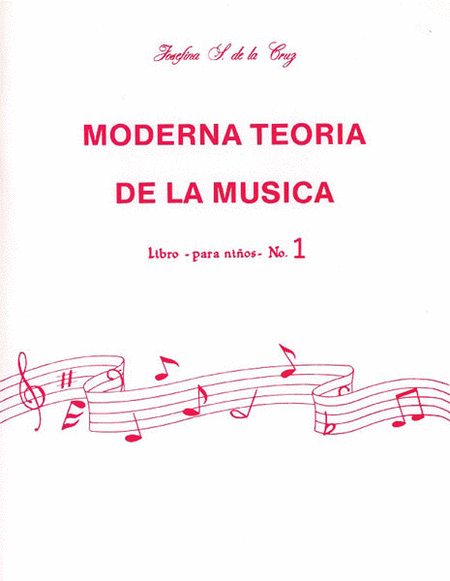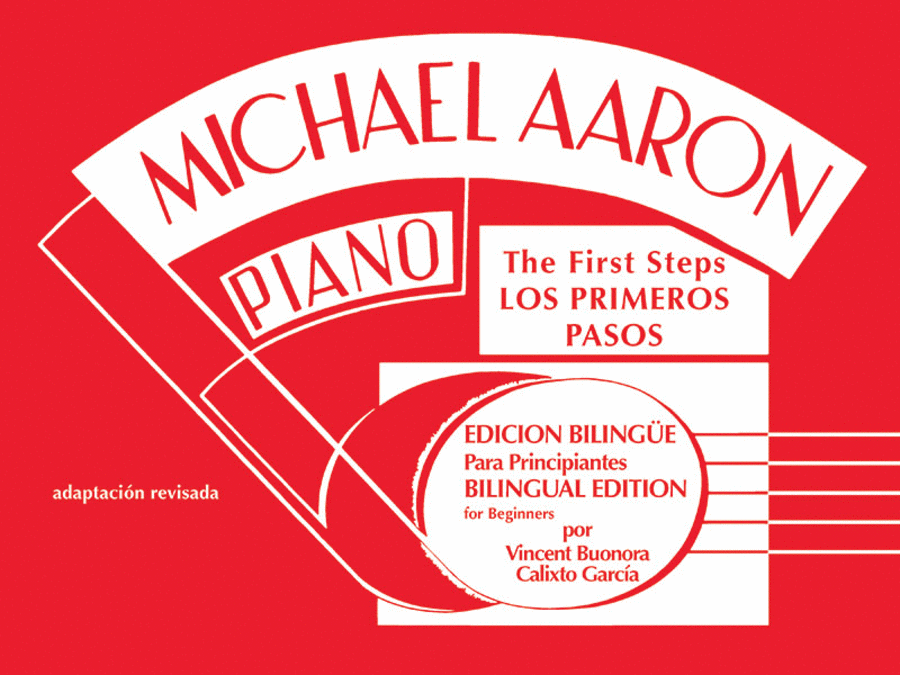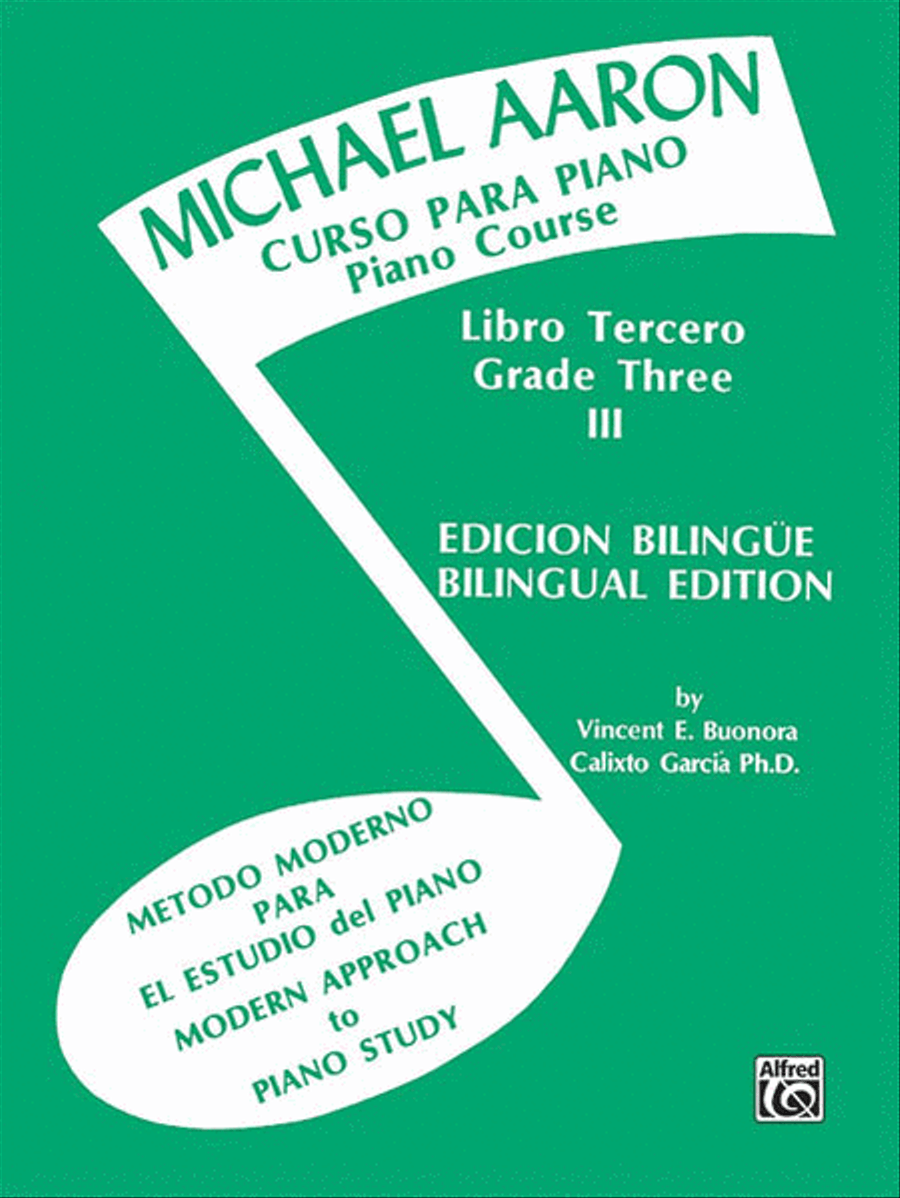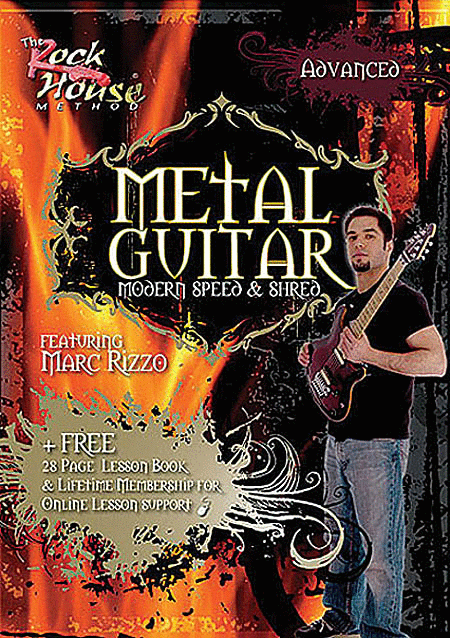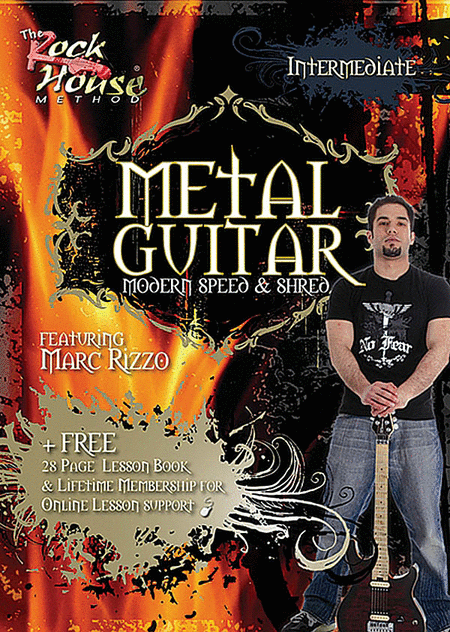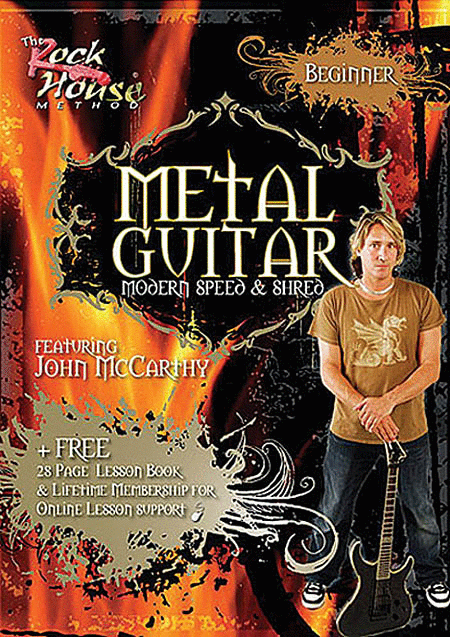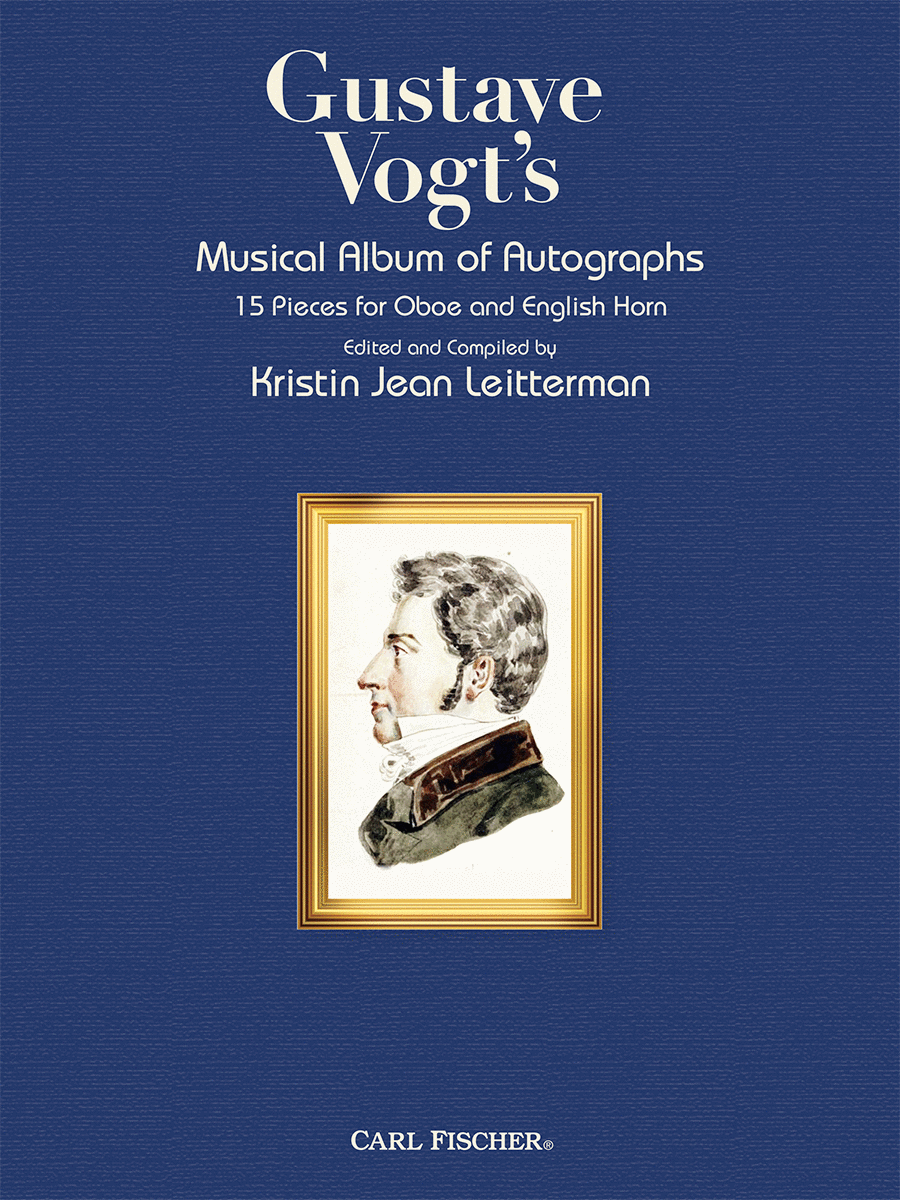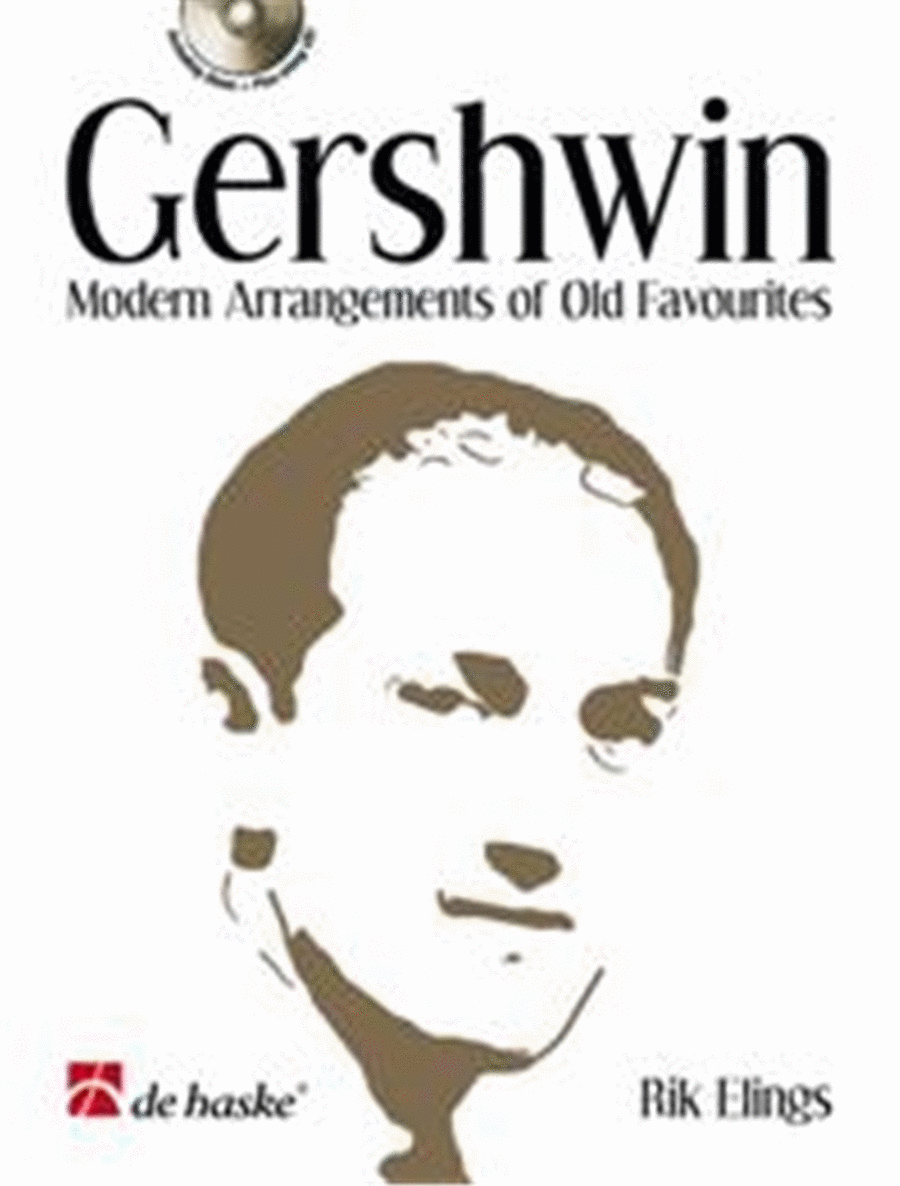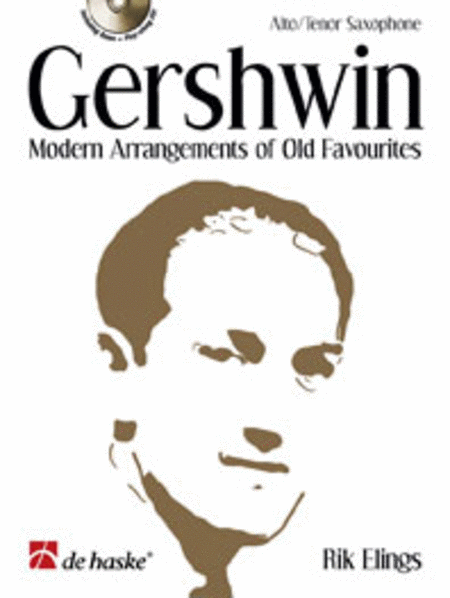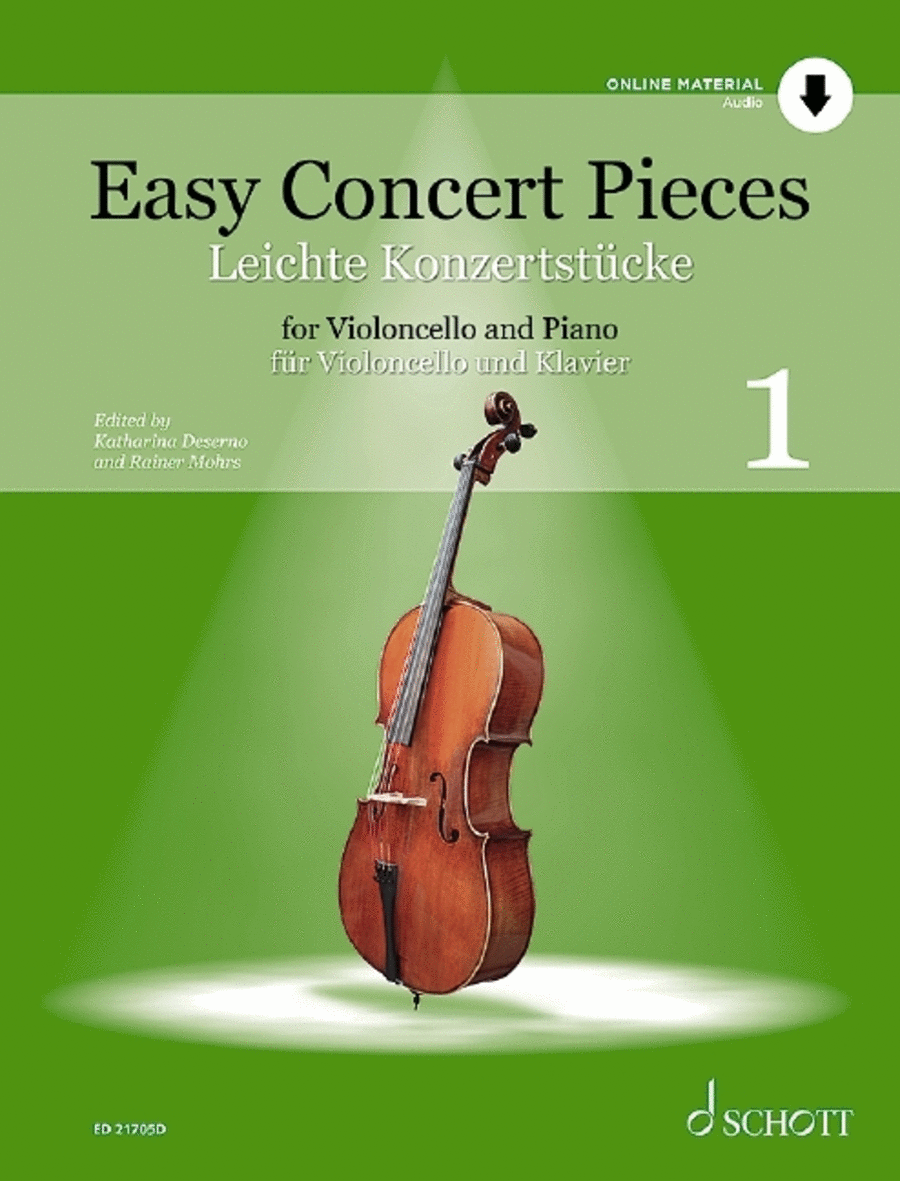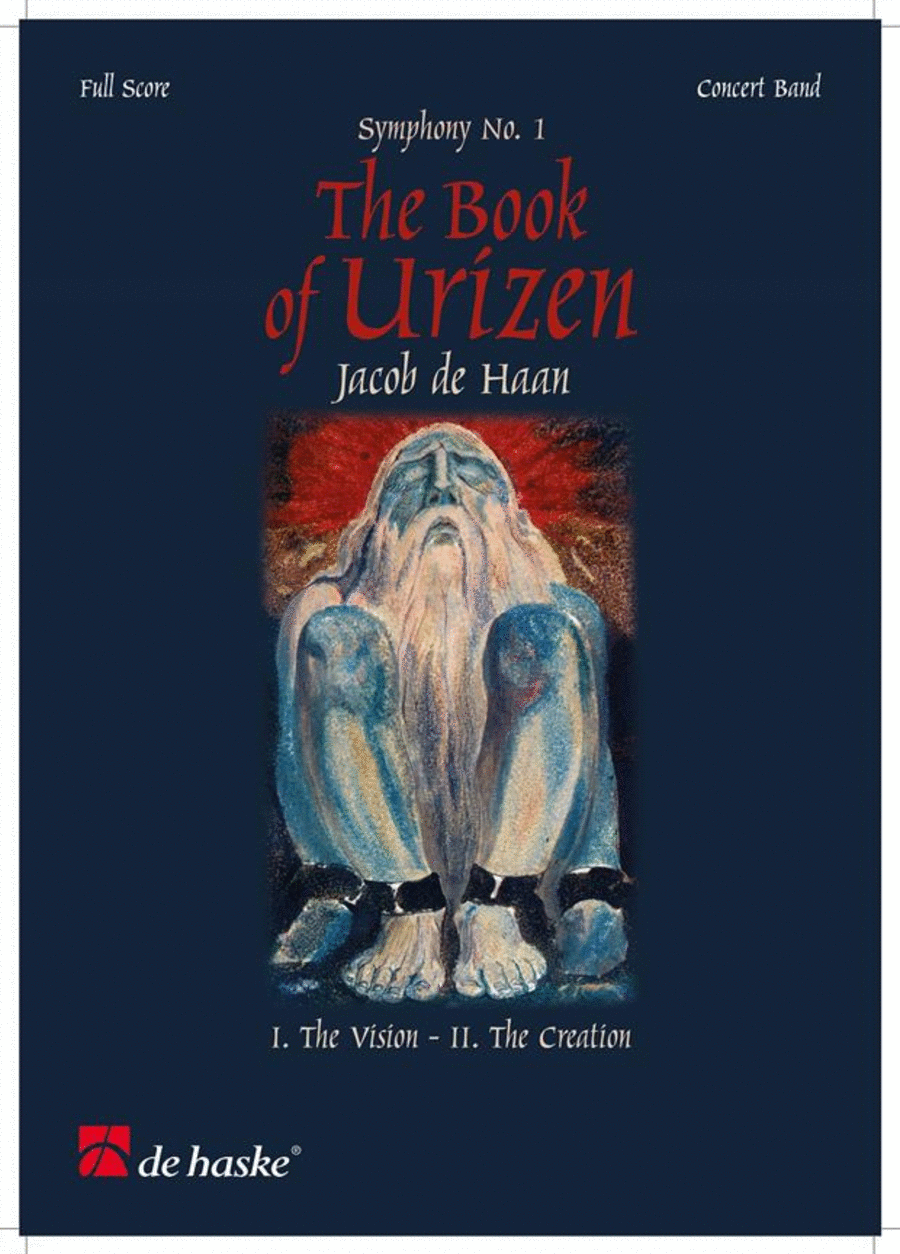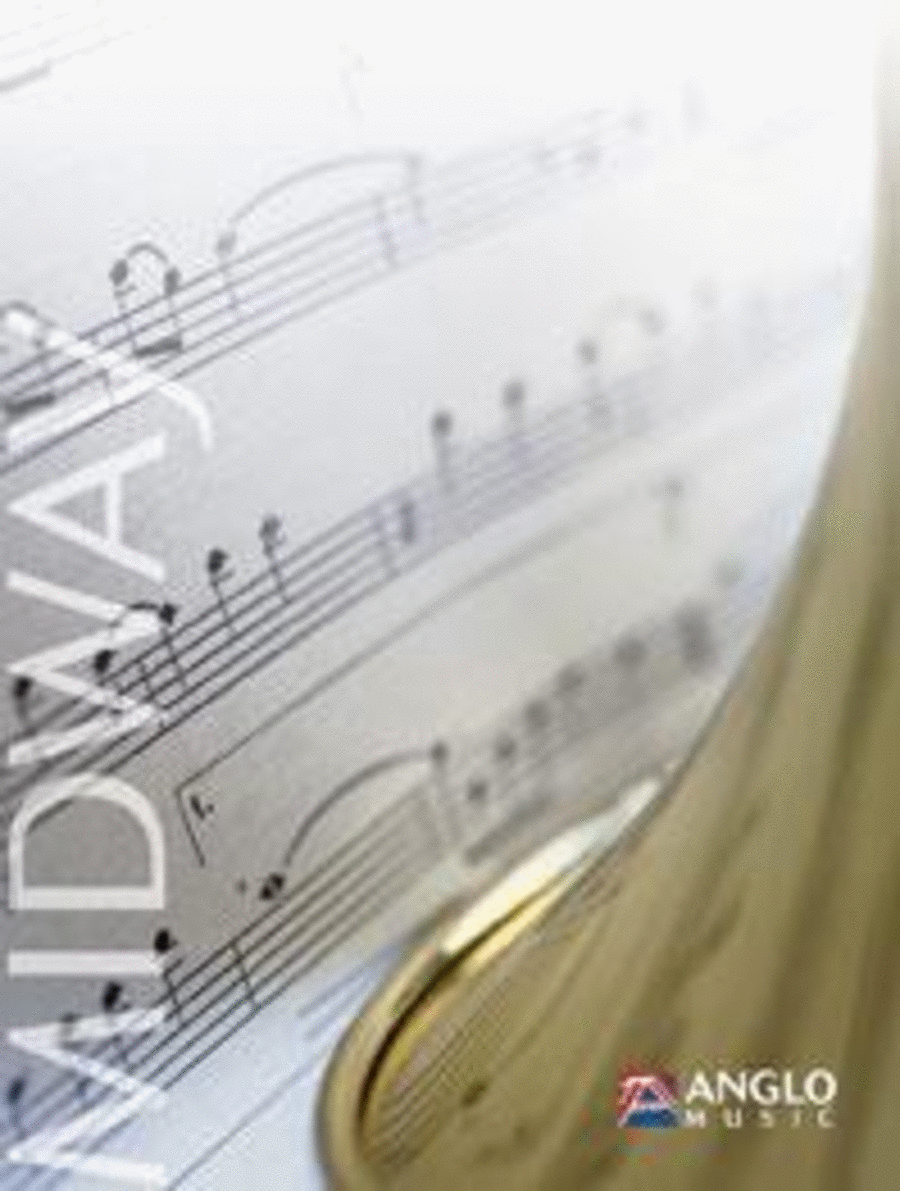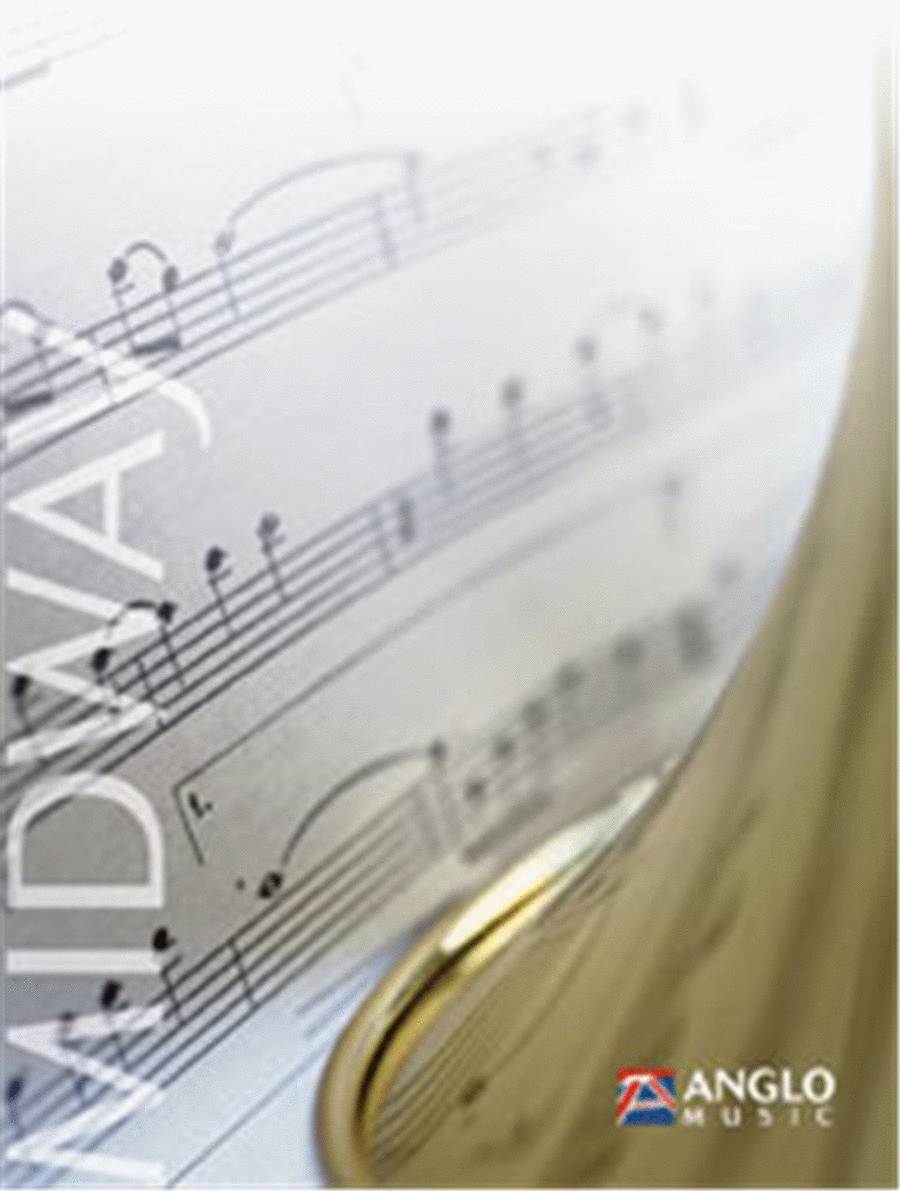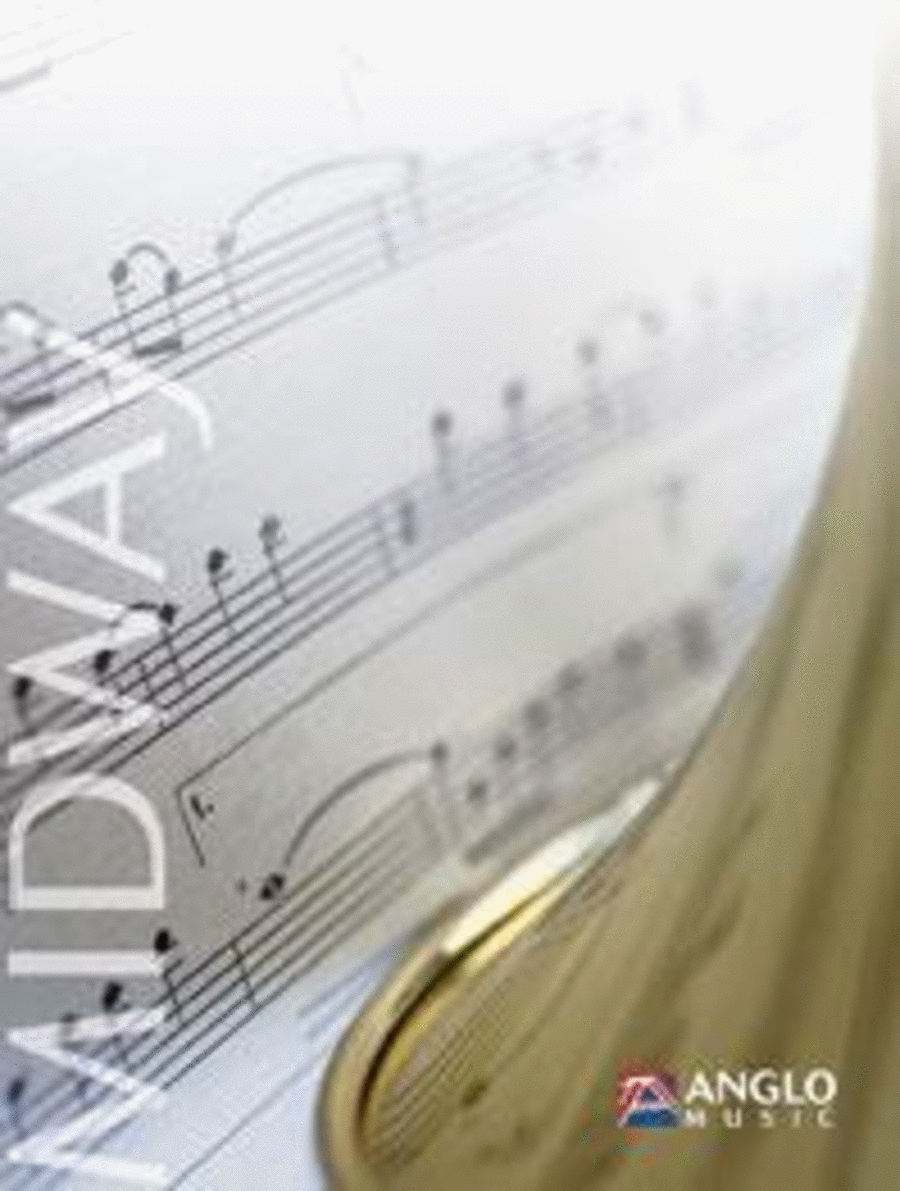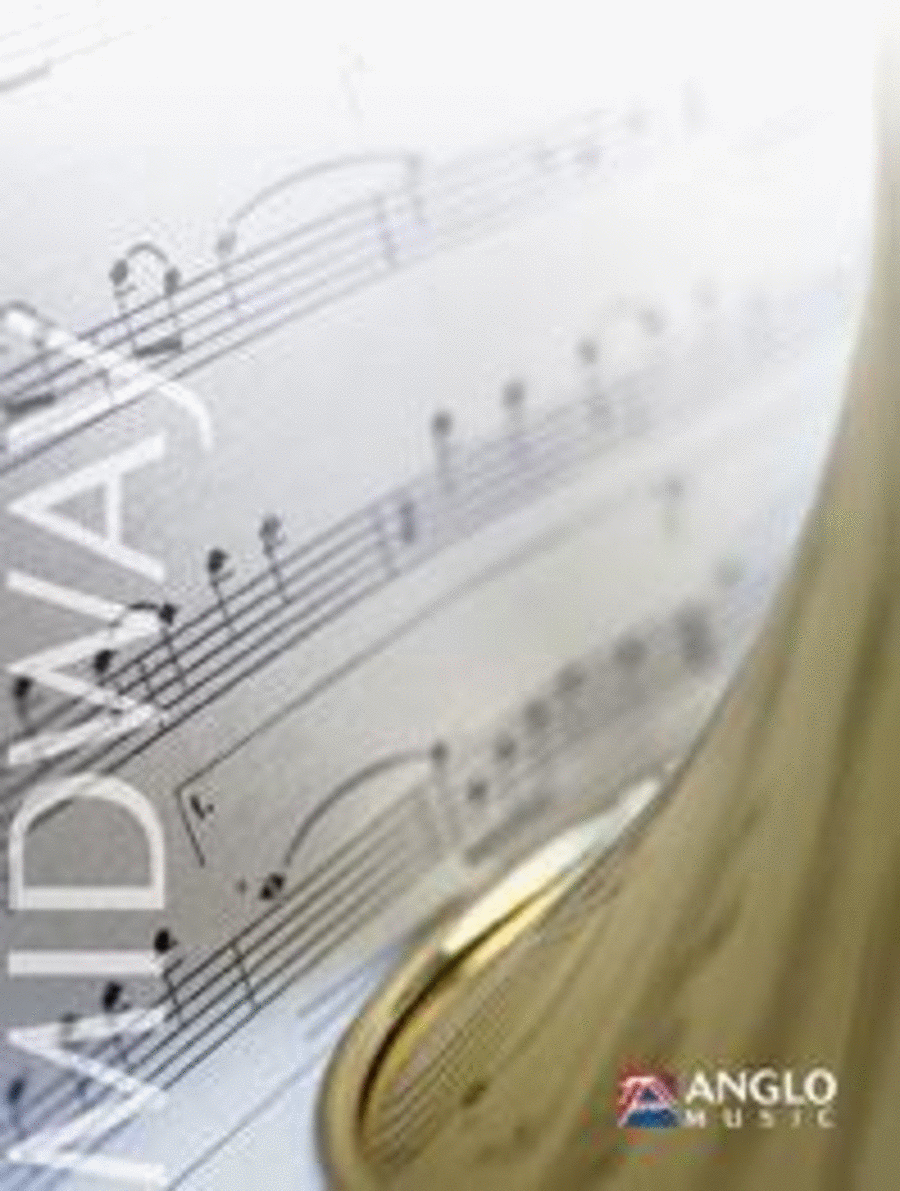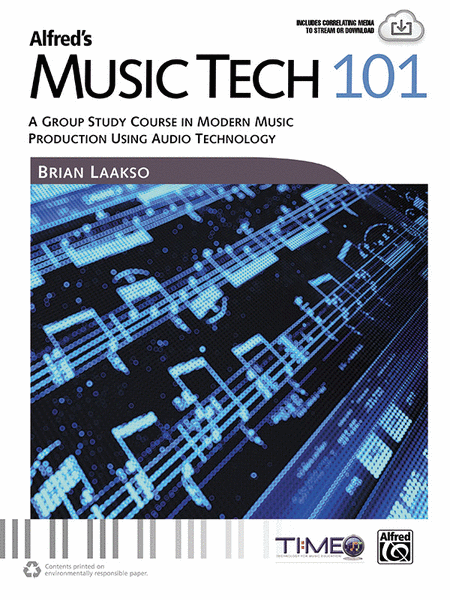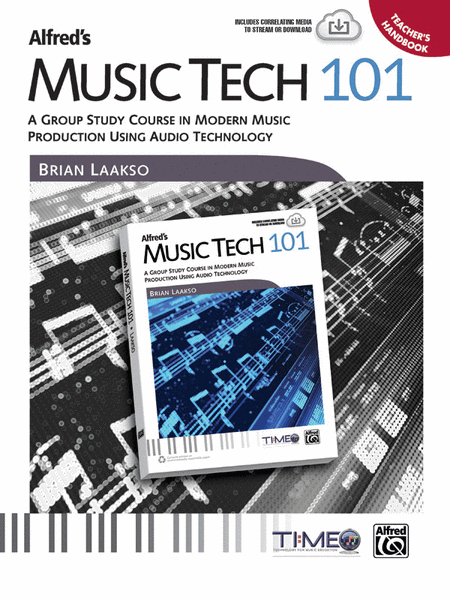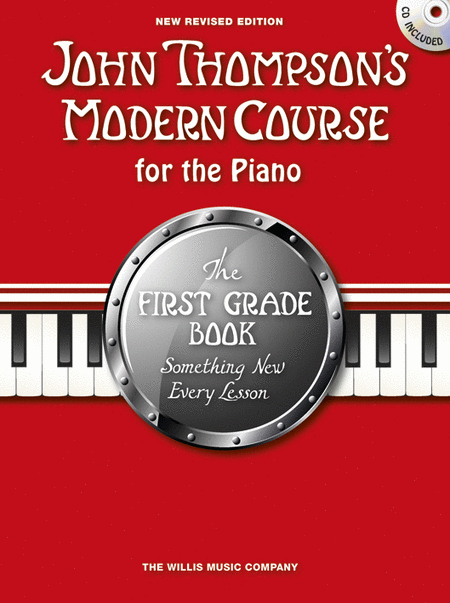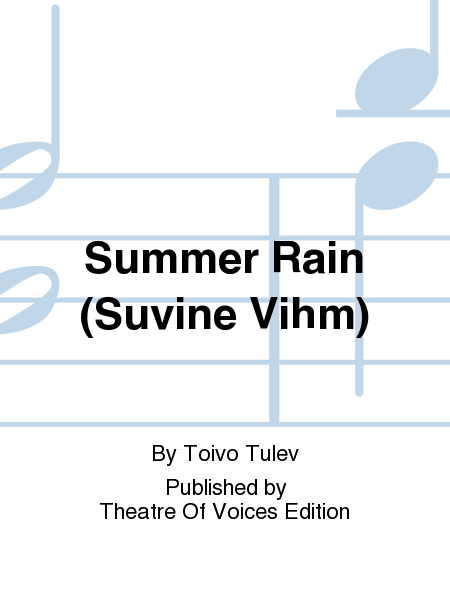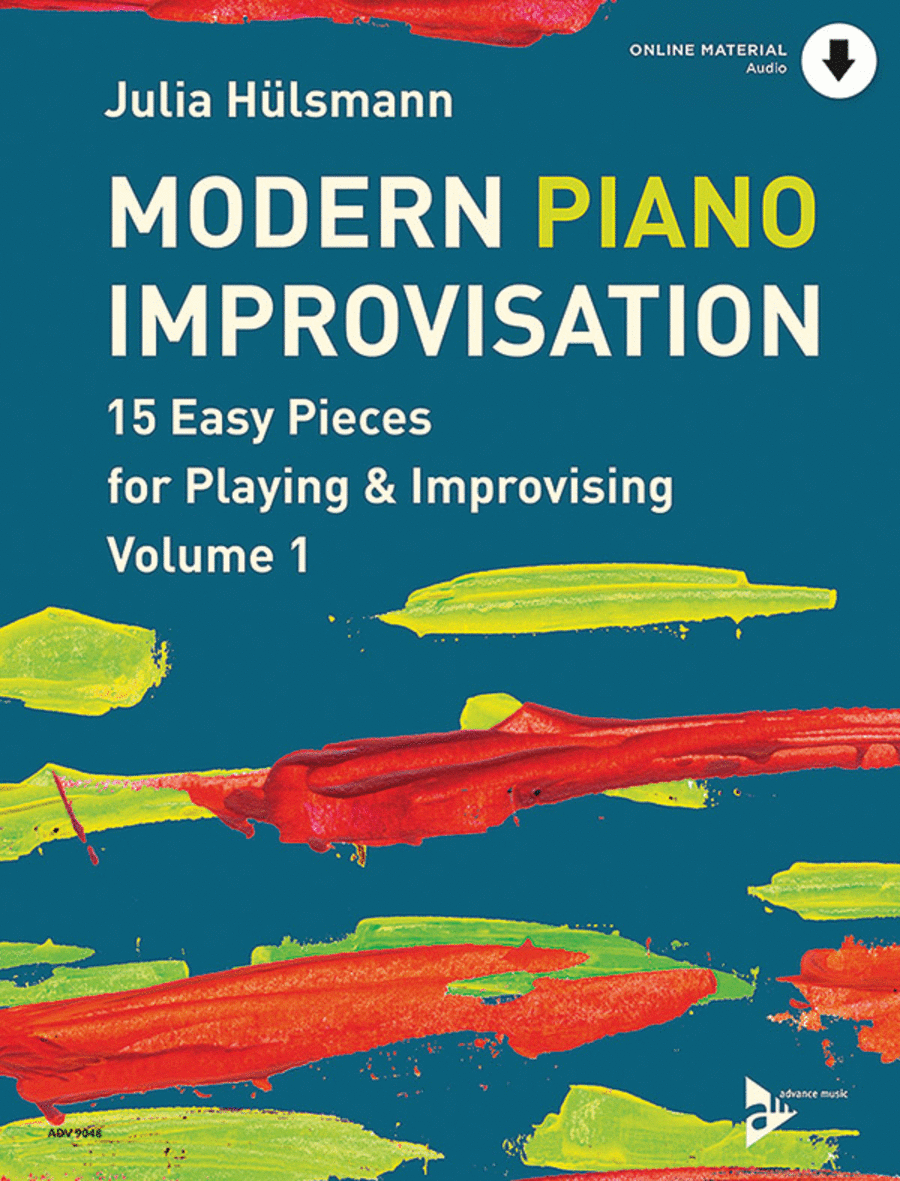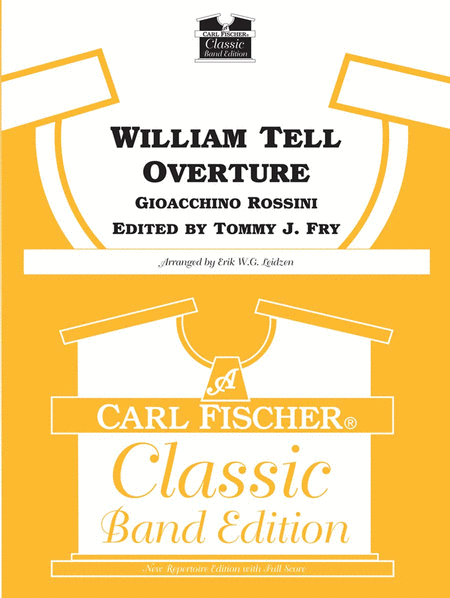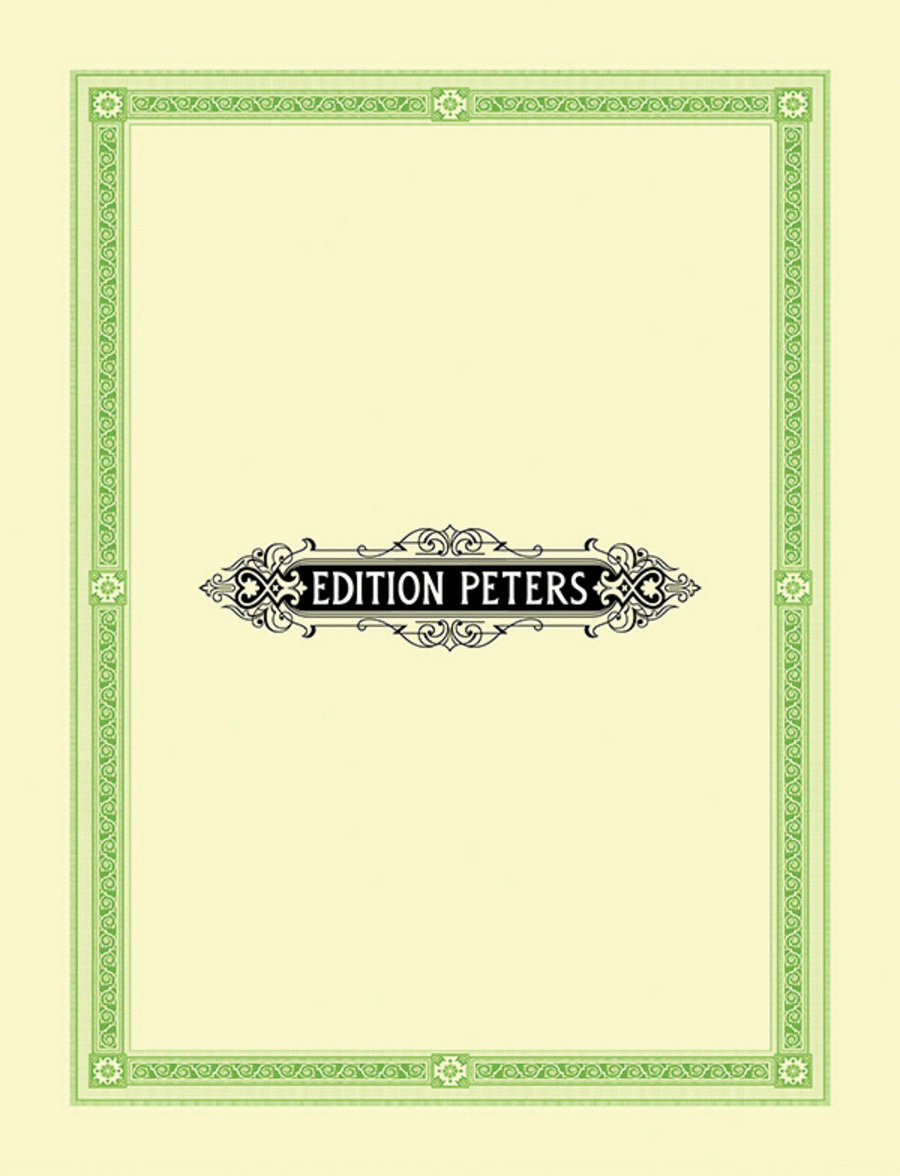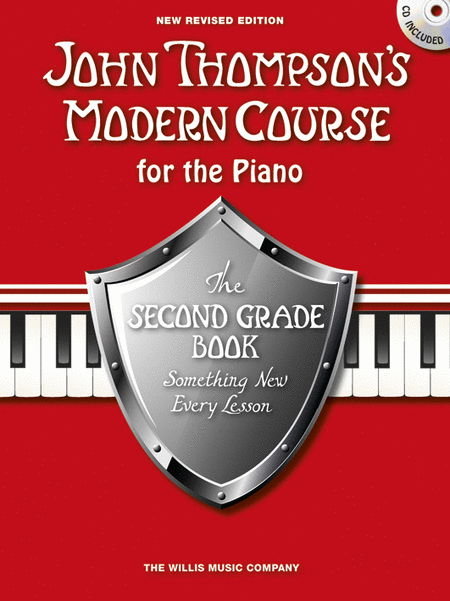|
| Moderna Teoria de la Musica
Piano seul [Partition]
Alfred Publishing
By Josefina S. De la Cruz. For Piano. Piano Theory Supplement. Moderna Teoria De...(+)
By Josefina S. De la
Cruz. For Piano. Piano
Theory Supplement.
Moderna Teoria De La
Musica. Latin. Book. Text
language: Spanish. 88
pages. Published by
Alfred Publishing.
$8.95 - Voir plus => AcheterDélais: 1 to 2 weeks | | | |
| Michael Aaron Piano Course (Curso Para Piano): Spanish and English Edition, Primer
Piano seul [Partition] - Débutant
Alfred Publishing
Michael Aaron Piano Course (Curso Para Piano). (Primer (Spanish, English Languag...(+)
Michael Aaron Piano
Course (Curso Para
Piano). (Primer (Spanish,
English Language
Edition)). By Michael
Aaron. For Piano.
Method/Instruction; Piano
- Aaron Method. Michael
Aaron Piano Course.
Latin. Beginner. Book.
Text language: Spanish.
40 pages. Published by
Alfred Music Publishing
(AP.11673X).
ISBN 0769238475. With
Text language: Spanish.
Latin.
$7.50 - Voir plus => AcheterDélais: 1 to 2 weeks | | | |
| Michael Aaron Piano Course (Curso Para Piano): Spanish and English Edition, Book 3
Piano seul [Partition] - Intermédiaire
Alfred Publishing
Michael Aaron Piano Course (Curso Para Piano), Book 3. (Spanish, English Languag...(+)
Michael Aaron Piano
Course (Curso Para
Piano), Book 3. (Spanish,
English Language
Edition). By Michael
Aaron. For Piano.
Method/Instruction; Piano
- Aaron Method. Michael
Aaron Piano Course.
Latin. Book. Text
language: Spanish. 64
pages. Published by
Alfred Music Publishing
(AP.11676X).
ISBN 0769238483. With
Text language: Spanish.
Latin.
Este libro ha sido
ampliado (agregando más
música y explicaciones
de términos musicales),
actualizado, y editado
(con énfasis en lectura
de las notas). [Spanish]
$6.99 - Voir plus => AcheterDélais: 1 to 2 weeks | | | |
| Metal Guitar Modern, Speed & Shred - DVD
Guitare notes et tablatures [DVD] - Intermédiaire/avancé
Fred Russell Publishing
By Marc Rizzo. Arranged by John Mccarthy. Metal. Level: Advanced. DVD, Instrumen...(+)
By Marc Rizzo. Arranged
by John Mccarthy. Metal.
Level: Advanced. DVD,
Instrumental Tutor. Text
language: English.
Published by Fred Russell
Publishing.
$19.99 - Voir plus => AcheterDélais: 3 to 5 business days | | | |
| Metal Guitar Modern, Speed & Shred - DVD
Guitare notes et tablatures [DVD] - Intermédiaire
Fred Russell Publishing
By Marc Rizzo. Arranged by John Mccarthy. Metal. Level: Intermediate. DVD, Instr...(+)
By Marc Rizzo. Arranged
by John Mccarthy. Metal.
Level: Intermediate. DVD,
Instrumental Tutor. Text
language: English.
Published by Fred Russell
Publishing.
$19.99 - Voir plus => AcheterDélais: 3 to 5 business days | | | |
| Metal Guitar Modern, Speed & Shred - DVD
Guitare notes et tablatures [DVD] - Débutant
Fred Russell Publishing
By John Mccarthy. Arranged by John Mccarthy. Metal. Level: Beginner. DVD, Instru...(+)
By John Mccarthy.
Arranged by John
Mccarthy. Metal. Level:
Beginner. DVD,
Instrumental Tutor. Text
language: English.
Published by Fred Russell
Publishing.
$19.99 - Voir plus => AcheterDélais: 24 hours - In Stock | | | |
| Gustave Vogt's Musical Album of Autographs
Cor anglais, Piano
Carl Fischer
Chamber Music English Horn, Oboe SKU: CF.WF229 15 Pieces for Oboe and ...(+)
Chamber Music English
Horn, Oboe SKU:
CF.WF229 15 Pieces
for Oboe and English
Horn. Composed by
Gustave Vogt. Edited by
Kristin Jean Leitterman.
Collection - Performance.
32+8 pages. Carl Fischer
Music #WF229. Published
by Carl Fischer Music
(CF.WF229). ISBN
9781491153789. UPC:
680160911288. Intro
duction Gustave Vogt's
Musical Paris Gustave
Vogt (1781-1870) was born
into the Age of
Enlightenment, at the
apex of the
Enlightenment's outreach.
During his lifetime he
would observe its effect
on the world. Over the
course of his life he
lived through many
changes in musical style.
When he was born,
composers such as Mozart
and Haydn were still
writing masterworks
revered today, and
eighty-nine years later,
as he departed the world,
the new realm of
Romanticism was beginning
to emerge with Mahler,
Richard Strauss and
Debussy, who were soon to
make their respective
marks on the musical
world. Vogt himself left
a huge mark on the
musical world, with
critics referring to him
as the grandfather of the
modern oboe and the
premier oboist of Europe.
Through his eighty-nine
years, Vogt would live
through what was perhaps
the most turbulent period
of French history. He
witnessed the French
Revolution of 1789,
followed by the many
newly established
governments, only to die
just months before the
establishment of the
Third Republic in 1870,
which would be the
longest lasting
government since the
beginning of the
revolution. He also
witnessed the
transformation of the
French musical world from
one in which opera
reigned supreme, to one
in which virtuosi,
chamber music, and
symphonic music ruled.
Additionally, he
experienced the
development of the oboe
right before his eyes.
When he began playing in
the late eighteenth
century, the standard
oboe had two keys (E and
Eb) and at the time of
his death in 1870, the
System Six Triebert oboe
(the instrument adopted
by Conservatoire
professor, Georges
Gillet, in 1882) was only
five years from being
developed. Vogt was born
March 18, 1781 in the
ancient town of
Strasbourg, part of the
Alsace region along the
German border. At the
time of his birth,
Strasbourg had been
annexed by Louis XIV, and
while heavily influenced
by Germanic culture, had
been loosely governed by
the French for a hundred
years. Although it is
unclear when Vogt began
studying the oboe and
when his family made its
move to the French
capital, the Vogts may
have fled Strasbourg in
1792 after much of the
city was destroyed during
the French Revolution. He
was without question
living in Paris by 1798,
as he enrolled on June 8
at the newly established
Conservatoire national de
Musique to study oboe
with the school's first
oboe professor,
Alexandre-Antoine
Sallantin (1775-1830).
Vogt's relationship with
the Conservatoire would
span over half a century,
moving seamlessly from
the role of student to
professor. In 1799, just
a year after enrolling,
he was awarded the
premier prix, becoming
the fourth oboist to
achieve this award. By
1802 he had been
appointed repetiteur,
which involved teaching
the younger students and
filling in for Sallantin
in exchange for a free
education. He maintained
this rank until 1809,
when he was promoted to
professor adjoint and
finally to professor
titulaire in 1816 when
Sallantin retired. This
was a position he held
for thirty-seven years,
retiring in 1853, making
him the longest serving
oboe professor in the
school's history. During
his tenure, he became the
most influential oboist
in France, teaching
eighty-nine students,
plus sixteen he taught
while he was professor
adjoint and professor
titulaire. Many of these
students went on to be
famous in their own
right, such as Henri Brod
(1799-1839), Apollon
Marie-Rose Barret
(1804-1879), Charles
Triebert (1810-1867),
Stanislas Verroust
(1814-1863), and Charles
Colin (1832-1881). His
influence stretches from
French to American oboe
playing in a direct line
from Charles Colin to
Georges Gillet
(1854-1920), and then to
Marcel Tabuteau
(1887-1966), the oboist
Americans lovingly
describe as the father of
American oboe playing.
Opera was an important
part of Vogt's life. His
first performing position
was with the
Theatre-Montansier while
he was still studying at
the Conservatoire.
Shortly after, he moved
to the Ambigu-Comique
and, in 1801 was
appointed as first oboist
with the Theatre-Italien
in Paris. He had been in
this position for only a
year, when he began
playing first oboe at the
Opera-Comique. He
remained there until
1814, when he succeeded
his teacher,
Alexandre-Antoine
Sallantin, as soloist
with the Paris Opera, the
top orchestra in Paris at
the time. He played with
the Paris Opera until
1834, all the while
bringing in his current
and past students to fill
out the section. In this
position, he began to
make a name for himself;
so much so that specific
performances were
immortalized in memoirs
and letters. One comes
from a young Hector
Berlioz (1803-1865) after
having just arrived in
Paris in 1822 and
attended the Paris
Opera's performance of
Mehul's Stratonice and
Persuis' ballet Nina. It
was in response to the
song Quand le bien-amie
reviendra that Berlioz
wrote: I find it
difficult to believe that
that song as sung by her
could ever have made as
true and touching an
effect as the combination
of Vogt's instrument...
Shortly after this,
Berlioz gave up studying
medicine and focused on
music. Vogt frequently
made solo and chamber
appearances throughout
Europe. His busiest
period of solo work was
during the 1820s. In 1825
and 1828 he went to
London to perform as a
soloist with the London
Philharmonic Society.
Vogt also traveled to
Northern France in 1826
for concerts, and then in
1830 traveled to Munich
and Stuttgart, visiting
his hometown of
Strasbourg on the way.
While on tour, Vogt
performed Luigi
Cherubini's (1760-1842)
Ave Maria, with soprano
Anna (Nanette) Schechner
(1806-1860), and a
Concertino, presumably
written by himself. As a
virtuoso performer in
pursuit of repertoire to
play, Vogt found himself
writing much of his own
music. His catalog
includes chamber music,
variation sets, vocal
music, concerted works,
religious music, wind
band arrangements, and
pedagogical material. He
most frequently performed
his variation sets, which
were largely based on
themes from popular
operas he had, presumably
played while he was at
the Opera. He made his
final tour in 1839,
traveling to Tours and
Bordeaux. During this
tour he appeared with the
singer Caroline Naldi,
Countess de Sparre, and
the violinist Joseph
Artot (1815-1845). This
ended his active career
as a soloist. His
performance was described
in the Revue et gazette
musicale de Paris as
having lost none of his
superiority over the
oboe.... It's always the
same grace, the same
sweetness. We made a trip
to Switzerland, just by
closing your eyes and
listening to Vogt's oboe.
Vogt was also active
performing in Paris as a
chamber and orchestral
musician. He was one of
the founding members of
the Societe des Concerts
du Conservatoire, a group
established in 1828 by
violinist and conductor
Francois-Antoine Habeneck
(1781-1849). The group
featured faculty and
students performing
alongside each other and
works such as Beethoven
symphonies, which had
never been heard in
France. He also premiered
the groundbreaking
woodwind quintets of
Antonin Reicha
(1770-1836). After his
retirement from the Opera
in 1834 and from the
Societe des Concerts du
Conservatoire in 1842,
Vogt began to slow down.
His final known
performance was of
Cherubini's Ave Maria on
English horn with tenor
Alexis Dupont (1796-1874)
in 1843. He then began to
reflect on his life and
the people he had known.
When he reached his 60s,
he began gathering
entries for his Musical
Album of Autographs.
Autograph Albums Vogt's
Musical Album of
Autographs is part of a
larger practice of
keeping autograph albums,
also commonly known as
Stammbuch or Album
Amicorum (meaning book of
friendship or friendship
book), which date back to
the time of the
Reformation and the
University of Wittenberg.
It was during the
mid-sixteenth century
that students at the
University of Wittenberg
began passing around
bibles for their fellow
students and professors
to sign, leaving messages
to remember them by as
they moved on to the next
part of their lives. The
things people wrote were
mottos, quotes, and even
drawings of their family
coat of arms or some
other scene that meant
something to the owner.
These albums became the
way these young students
remembered their school
family once they had
moved on to another
school or town. It was
also common for the
entrants to comment on
other entries and for the
owner to amend entries
when they learned of
important life details
such as marriage or
death. As the practice
continued, bibles were
set aside for emblem
books, which was a
popular book genre that
featured allegorical
illustrations (emblems)
in a tripartite form:
image, motto, epigram.
The first emblem book
used for autographs was
published in 1531 by
Andrea Alciato
(1492-1550), a collection
of 212 Latin emblem
poems. In 1558, the first
book conceived for the
purpose of the album
amicorum was published by
Lyon de Tournes
(1504-1564) called the
Thesaurus Amicorum. These
books continued to
evolve, and spread to
wider circles away from
universities. Albums
could be found being kept
by noblemen, physicians,
lawyers, teachers,
painters, musicians, and
artisans. The albums
eventually became more
specialized, leading to
Musical Autograph Albums
(or Notestammbucher).
Before this
specialization, musicians
contributed in one form
or another, but our
knowledge of them in
these albums is mostly
limited to individual
people or events. Some
would simply sign their
name while others would
insert a fragment of
music, usually a canon
(titled fuga) with text
in Latin. Canons were
popular because they
displayed the
craftsmanship of the
composer in a limited
space. Composers
well-known today,
including J. S. Bach,
Telemann, Mozart,
Beethoven, Dowland, and
Brahms, all participated
in the practice, with
Beethoven being the first
to indicate an interest
in creating an album only
of music. This interest
came around 1815. In an
1845 letter from Johann
Friedrich Naue to
Heinrich Carl
Breidenstein, Naue
recalled an 1813 visit
with Beethoven, who
presented a book
suggesting Naue to
collect entries from
celebrated musicians as
he traveled. Shortly
after we find Louis Spohr
speaking about leaving on
his grand tour through
Europe in 1815 and of his
desire to carry an album
with entries from the
many artists he would
come across. He wrote in
his autobiography that
his most valuable
contribution came from
Beethoven in 1815.
Spohr's Notenstammbuch,
comprised only of musical
entries, is
groundbreaking because it
was coupled with a
concert tour, allowing
him to reach beyond the
Germanic world, where the
creation of these books
had been nearly
exclusive. Spohr brought
the practice of
Notenstammbucher to
France, and in turn
indirectly inspired Vogt
to create a book of his
own some fifteen years
later. Vogt's Musical
Album of Autographs
Vogt's Musical Album of
Autographs acts as a form
of a memoir, displaying
mementos of musicians who
held special meaning in
his life as well as
showing those with whom
he was enamored from the
younger generation. The
anonymous Pie Jesu
submitted to Vogt in 1831
marks the beginning of an
album that would span
nearly three decades by
the time the final entry,
an excerpt from Charles
Gounod's (1818-1893)
Faust, which premiered in
1859, was submitted.
Within this album we find
sixty-two entries from
musicians whom he must
have known very well
because they were
colleagues at the
Conservatoire, or
composers of opera whose
works he was performing
with the Paris Opera.
Other entries came from
performers with whom he
had performed and some
who were simply passing
through Paris, such as
Joseph Joachim
(1831-1907). Of the
sixty-three total
entries, some are
original, unpublished
works, while others came
from well-known existing
works. Nineteen of these
works are for solo piano,
sixteen utilize the oboe
or English horn, thirteen
feature the voice (in
many different
combinations, including
vocal solos with piano,
and small choral settings
up to one with double
choir), two feature
violin as a solo
instrument, and one even
features the now obscure
ophicleide. The
connections among the
sixty-two contributors to
Vogt's album are
virtually never-ending.
All were acquainted with
Vogt in some capacity,
from long-time
friendships to
relationships that were
created when Vogt
requested their entry.
Thus, while Vogt is the
person who is central to
each of these musicians,
the web can be greatly
expanded. In general, the
connections are centered
around the Conservatoire,
teacher lineages, the
Opera, and performing
circles. The
relationships between all
the contributors in the
album parallel the
current musical world, as
many of these kinds of
relationships still
exist, and permit us to
fantasize who might be
found in an album created
today by a musician of
the same standing. Also
important, is what sort
of entries the
contributors chose to
pen. The sixty-three
entries are varied, but
can be divided into
published and unpublished
works. Within the
published works, we find
opera excerpts, symphony
excerpts, mass excerpts,
and canons, while the
unpublished works include
music for solo piano,
oboe or English horn,
string instruments
(violin and cello), and
voice (voice with piano
and choral). The music
for oboe and English horn
works largely belong in
the unpublished works of
the album. These entries
were most likely written
to honor Vogt. Seven are
for oboe and piano and
were contributed by
Joseph Joachim, Pauline
Garcia Viardot
(1821-1910), Joseph
Artot, Anton Bohrer
(1783-1852), Georges
Onslow (1784-1853),
Desire Beaulieu
(1791-1863), and Narcisse
Girard (1797-1860). The
common thread between
these entries is the
simplicity of the melody
and structure. Many are
repetitive, especially
Beaulieu's entry, which
features a two-note
ostinato throughout the
work, which he even
included in his
signature. Two composers
contributed pieces for
English horn and piano,
and like the previous
oboe entries, are simple
and repetitive. These
were written by Michele
Carafa (1787-1872) and
Louis Clapisson
(1808-1866). There are
two other entries that
were unpublished works
and are chamber music.
One is an oboe trio by
Jacques Halevy
(1799-1862) and the other
is for oboe and strings
(string trio) by J. B.
Cramer (1771-1858). There
are five published works
in the album for oboe and
English horn. There are
three from operas and the
other two from symphonic
works. Ambroise Thomas
(1811-1896) contributed
an excerpt from the
Entr'acte of his opera La
Guerillero, and was
likely chosen because the
oboe was featured at this
moment. Hippolyte Chelard
(1789-1861) also chose to
honor Vogt by writing for
English horn. His entry,
for English horn and
piano, is taken from his
biggest success, Macbeth.
The English horn part was
actually taken from Lady
Macbeth's solo in the
sleepwalking scene.
Vogt's own entry also
falls into this category,
as he entered an excerpt
from Donizetti's Maria di
Rohan. The excerpt he
chose is a duet between
soprano and English horn.
There are two entries
featuring oboe that are
excerpted from symphonic
repertoire. One is a
familiar oboe melody from
Beethoven's Pastoral
Symphony entered by his
first biographer, Anton
Schindler (1796-1864).
The other is an excerpt
from Berlioz's choral
symphony, Romeo et
Juliette. He entered an
oboe solo from the Grand
Fete section of the
piece. Pedagogical
benefit All of these
works are lovely, and fit
within the album
wonderfully, but these
works also are great oboe
and English horn music
for young students. The
common thread between
these entries is the
simplicity of the melody
and structure. Many are
repetitive, especially
Beaulieu's entry, which
features a two-note
ostinato throughout the
work in the piano. This
repetitive structure is
beneficial for young
students for searching
for a short solo to
present at a studio
recital, or simply to
learn. They also work
many technical issues a
young player may
encounter, such as
mastering the rolling
finger to uncover and
recover the half hole.
This is true of Bealieu's
Pensee as well as
Onslow's Andantino.
Berlioz's entry from
Romeo et Juliette
features very long
phrases, which helps with
endurance and helps keep
the air spinning through
the oboe. Some of the
pieces also use various
levels of ornamentation,
from trills to grace
notes, and short
cadenzas. This allows the
student to learn
appropriate ways to
phrase with these added
notes. The chamber music
is a valuable way to
start younger students
with chamber music,
especially the short
quartet by Cramer for
oboe and string trio. All
of these pieces will not
tax the student to learn
a work that is more
advanced, as well as give
them a full piece that
they can work on from
beginning to end in a
couple weeks, instead of
months. Editorial Policy
The works found in this
edition are based on the
manuscript housed at the
Morgan Library in New
York City (call number
Cary 348, V886. A3). When
possible, published
scores were consulted and
compared to clarify pitch
and text. The general
difficulties in creating
an edition of these works
stem from entries that
appear to be hastily
written, and thus omit
complete articulations
and dynamic indications
for all passages and
parts. The manuscript has
been modernized into a
performance edition. The
score order from the
manuscript has been
retained. If an entry
also exists in a
published work, and this
was not indicated on the
manuscript, appropriate
titles and subtitles have
been added tacitly. For
entries that were
untitled, the beginning
tempo marking or
expressive directive has
been added as its title
tacitly. Part names have
been changed from the
original language to
English. If no part name
was present, it was added
tacitly. All scores are
transposing where
applicable. Measure
numbers have been added
at the beginning of every
system. Written
directives have been
retained in the original
language and are placed
relative to where they
appear in the manuscript.
Tempo markings from the
manuscript have been
retained, even if they
were abbreviated, i.e.,
Andte. The barlines,
braces, brackets, and
clefs are modernized. The
beaming and stem
direction has been
modernized. Key
signatures have been
modernized as some of the
flats/sharps do not
appear on the correct
lines or spaces. Time
signatures have been
modernized. In a few
cases, when a time
signature was missing in
the manuscript, it has
been added tacitly.
Triplet and rhythmic
groupings have been
modernized. Slurs, ties,
and articulations
(staccato and accent)
have been modernized.
Slurs, ties, and
articulations have been
added to parallel
passages tacitly.
Courtesy accidentals
found in the manuscript
have been removed, unless
it appeared to be helpful
to the performer. Dynamic
indications from the
manuscript have been
retained, except where
noted. --Kristin
Leitterman.
Introducti
onGustave Vogt’s
Musical ParisGustave Vogt
(1781–1870) was
born into the “Age
of Enlightenment,â€
at the apex of the
Enlightenment’s
outreach. During his
lifetime he would observe
its effect on the world.
Over the course of his
life he lived through
many changes in musical
style. When he was born,
composers such as Mozart
and Haydn were still
writing masterworks
revered today, and
eighty-nine years later,
as he departed the world,
the new realm of
Romanticism was beginning
to emerge with Mahler,
Richard Strauss and
Debussy, who were soon to
make their respective
marks on the musical
world. Vogt himself left
a huge mark on the
musical world, with
critics referring to him
as the “grandfather
of the modern oboeâ€
and the “premier
oboist of
Europe.â€Through his
eighty-nine years, Vogt
would live through what
was perhaps the most
turbulent period of
French history. He
witnessed the French
Revolution of 1789,
followed by the many
newly established
governments, only to die
just months before the
establishment of the
Third Republic in 1870,
which would be the
longest lasting
government since the
beginning of the
revolution. He also
witnessed the
transformation of the
French musical world from
one in which opera
reigned supreme, to one
in which virtuosi,
chamber music, and
symphonic music ruled.
Additionally, he
experienced the
development of the oboe
right before his eyes.
When he began playing in
the late eighteenth
century, the standard
oboe had two keys (E and
Eb) and at the time of
his death in 1870, the
“System Sixâ€
Triébert oboe (the
instrument adopted by
Conservatoire professor,
Georges Gillet, in 1882)
was only five years from
being developed.Vogt was
born March 18, 1781 in
the ancient town of
Strasbourg, part of the
Alsace region along the
German border. At the
time of his birth,
Strasbourg had been
annexed by Louis XIV, and
while heavily influenced
by Germanic culture, had
been loosely governed by
the French for a hundred
years. Although it is
unclear when Vogt began
studying the oboe and
when his family made its
move to the French
capital, the Vogts may
have fled Strasbourg in
1792 after much of the
city was destroyed during
the French Revolution. He
was without question
living in Paris by 1798,
as he enrolled on June 8
at the newly established
Conservatoire national de
Musique to study oboe
with the school’s
first oboe professor,
Alexandre-Antoine
Sallantin
(1775–1830).Vogtâ
€™s relationship with
the Conservatoire would
span over half a century,
moving seamlessly from
the role of student to
professor. In 1799, just
a year after enrolling,
he was awarded the
premier prix, becoming
the fourth oboist to
achieve this award. By
1802 he had been
appointed
répétiteur, which
involved teaching the
younger students and
filling in for Sallantin
in exchange for a free
education. He maintained
this rank until 1809,
when he was promoted to
professor adjoint and
finally to professor
titulaire in 1816 when
Sallantin retired. This
was a position he held
for thirty-seven years,
retiring in 1853, making
him the longest serving
oboe professor in the
school’s history.
During his tenure, he
became the most
influential oboist in
France, teaching
eighty-nine students,
plus sixteen he taught
while he was professor
adjoint and professor
titulaire. Many of these
students went on to be
famous in their own
right, such as Henri Brod
(1799–1839),
Apollon Marie-Rose Barret
(1804–1879),
Charles Triebert
(1810–1867),
Stanislas Verroust
(1814–1863), and
Charles Colin
(1832–1881). His
influence stretches from
French to American oboe
playing in a direct line
from Charles Colin to
Georges Gillet
(1854–1920), and
then to Marcel Tabuteau
(1887–1966), the
oboist Americans lovingly
describe as the
“father of American
oboe playing.â€Opera
was an important part of
Vogt’s life. His
first performing position
was with the
Théâtre-Montansier
while he was still
studying at the
Conservatoire. Shortly
after, he moved to the
Ambigu-Comique and, in
1801 was appointed as
first oboist with the
Théâtre-Italien in
Paris. He had been in
this position for only a
year, when he began
playing first oboe at the
Opéra-Comique. He
remained there until
1814, when he succeeded
his teacher,
Alexandre-Antoine
Sallantin, as soloist
with the Paris Opéra,
the top orchestra in
Paris at the time. He
played with the Paris
Opéra until 1834, all
the while bringing in his
current and past students
to fill out the section.
In this position, he
began to make a name for
himself; so much so that
specific performances
were immortalized in
memoirs and letters. One
comes from a young Hector
Berlioz
(1803–1865) after
having just arrived in
Paris in 1822 and
attended the Paris
Opéra’s
performance of
Mehul’s Stratonice
and Persuis’
ballet Nina. It was in
response to the song
Quand le bien-amié
reviendra that Berlioz
wrote: “I find it
difficult to believe that
that song as sung by her
could ever have made as
true and touching an
effect as the combination
of Vogt’s
instrument…â€
Shortly after this,
Berlioz gave up studying
medicine and focused on
music.Vogt frequently
made solo and chamber
appearances throughout
Europe. His busiest
period of solo work was
during the 1820s. In 1825
and 1828 he went to
London to perform as a
soloist with the London
Philharmonic Society.
Vogt also traveled to
Northern France in 1826
for concerts, and then in
1830 traveled to Munich
and Stuttgart, visiting
his hometown of
Strasbourg on the way.
While on tour, Vogt
performed Luigi
Cherubini’s
(1760–1842) Ave
Maria, with soprano Anna
(Nanette) Schechner
(1806–1860), and a
Concertino, presumably
written by himself. As a
virtuoso performer in
pursuit of repertoire to
play, Vogt found himself
writing much of his own
music. His catalog
includes chamber music,
variation sets, vocal
music, concerted works,
religious music, wind
band arrangements, and
pedagogical material. He
most frequently performed
his variation sets, which
were largely based on
themes from popular
operas he had, presumably
played while he was at
the Opéra.He made his
final tour in 1839,
traveling to Tours and
Bordeaux. During this
tour he appeared with the
singer Caroline Naldi,
Countess de Sparre, and
the violinist Joseph
Artôt
(1815–1845). This
ended his active career
as a soloist. His
performance was described
in the Revue et gazette
musicale de Paris as
having “lost none
of his superiority over
the oboe….
It’s always the
same grace, the same
sweetness. We made a trip
to Switzerland, just by
closing your eyes and
listening to
Vogt’s
oboe.â€Vogt was also
active performing in
Paris as a chamber and
orchestral musician. He
was one of the founding
members of the
Société des
Concerts du
Conservatoire, a group
established in 1828 by
violinist and conductor
François-Antoine
Habeneck
(1781–1849). The
group featured faculty
and students performing
alongside each other and
works such as Beethoven
symphonies, which had
never been heard in
France. He also premiered
the groundbreaking
woodwind quintets of
Antonin Reicha
(1770–1836).After
his retirement from the
Opéra in 1834 and from
the Société des
Concerts du Conservatoire
in 1842, Vogt began to
slow down. His final
known performance was of
Cherubini’s Ave
Maria on English horn
with tenor Alexis Dupont
(1796–1874) in
1843. He then began to
reflect on his life and
the people he had known.
When he reached his 60s,
he began gathering
entries for his Musical
Album of
Autographs.Autograph
AlbumsVogt’s
Musical Album of
Autographs is part of a
larger practice of
keeping autograph albums,
also commonly known as
Stammbuch or Album
Amicorum (meaning book of
friendship or friendship
book), which date back to
the time of the
Reformation and the
University of Wittenberg.
It was during the
mid-sixteenth century
that students at the
University of Wittenberg
began passing around
bibles for their fellow
students and professors
to sign, leaving messages
to remember them by as
they moved on to the next
part of their lives. The
things people wrote were
mottos, quotes, and even
drawings of their family
coat of arms or some
other scene that meant
something to the owner.
These albums became the
way these young students
remembered their school
family once they had
moved on to another
school or town. It was
also common for the
entrants to comment on
other entries and for the
owner to amend entries
when they learned of
important life details
such as marriage or
death.As the practice
continued, bibles were
set aside for emblem
books, which was a
popular book genre that
featured allegorical
illustrations (emblems)
in a tripartite form:
image, motto, epigram.
The first emblem book
used for autographs was
published in 1531 by
Andrea Alciato
(1492–1550), a
collection of 212 Latin
emblem poems. In 1558,
the first book conceived
for the purpose of the
album amicorum was
published by Lyon de
Tournes
(1504–1564) called
the Thesaurus Amicorum.
These books continued to
evolve, and spread to
wider circles away from
universities. Albums
could be found being kept
by noblemen, physicians,
lawyers, teachers,
painters, musicians, and
artisans.The albums
eventually became more
specialized, leading to
Musical Autograph Albums
(or Notestammbücher).
Before this
specialization, musicians
contributed in one form
or another, but our
knowledge of them in
these albums is mostly
limited to individual
people or events. Some
would simply sign their
name while others would
insert a fragment of
music, usually a canon
(titled fuga) with text
in Latin. Canons were
popular because they
displayed the
craftsmanship of the
composer in a limited
space. Composers
well-known today,
including J. S. Bach,
Telemann, Mozart,
Beethoven, Dowland, and
Brahms, all participated
in the practice, with
Beethoven being the first
to indicate an interest
in creating an album only
of music.This interest
came around 1815. In an
1845 letter from Johann
Friedrich Naue to
Heinrich Carl
Breidenstein, Naue
recalled an 1813 visit
with Beethoven, who
presented a book
suggesting Naue to
collect entries from
celebrated musicians as
he traveled. Shortly
after we find Louis Spohr
speaking about leaving on
his “grand
tour†through
Europe in 1815 and of his
desire to carry an album
with entries from the
many artists he would
come across. He wrote in
his autobiography that
his “most valuable
contribution†came
from Beethoven in 1815.
Spohr’s
Notenstammbuch, comprised
only of musical entries,
is groundbreaking because
it was coupled with a
concert tour, allowing
him to reach beyond the
Germanic world, where the
creation of these books
had been nearly
exclusive. Spohr brought
the practice of
Notenstammbücher to
France, and in turn
indirectly inspired Vogt
to create a book of his
own some fifteen years
later.Vogt’s
Musical Album of
AutographsVogt’s
Musical Album of
Autographs acts as a form
of a memoir, displaying
mementos of musicians who
held special meaning in
his life as well as
showing those with whom
he was enamored from the
younger generation. The
anonymous Pie Jesu
submitted to Vogt in 1831
marks the beginning of an
album that would span
nearly three decades by
the time the final entry,
an excerpt from Charles
Gounod’s
(1818–1893) Faust,
which premiered in 1859,
was submitted.Within this
album ... $16.99 - Voir plus => AcheterDélais: 1 to 2 weeks | | | |
| Gershwin: Modern Arrangements of Old Favourites
Clarinette [Partition + CD] - Intermédiaire
De Haske Publications
Clarinet - late intermediate SKU: BT.DHP-1084513-400 Modern Arrangemen...(+)
Clarinet - late
intermediate SKU:
BT.DHP-1084513-400
Modern Arrangements of
Old Favourites.
Composed by George
Gershwin. Arranged by Rik
Elings. Book with CD.
Composed 2008. 28 pages.
De Haske Publications
#DHP 1084513-400.
Published by De Haske
Publications
(BT.DHP-1084513-400).
ISBN 9789043130080.
9x12 inches.
English-German-French-Dut
ch. The
compositions of George
Gershwin have a special
place in jazz music.
Every professional jazz
musician knows the
Gershwin songs. Although
composed long ago - in
the first half of the
previous century - they
remain ever popular.
Simply because of the
genius of the melodies,
rhythms, and texts, the
Gershwin tunes have
transcended their
original conception and
are still extremely
popular. In his own
characteristic manner,
Rik Elings has arranged
these Gershwin melodies
in a contemporary and
interesting fashion.
Everyone - amateur
musicians, students of
jazz, and audiences alike
- will take pleasure in
Elingâ??s inspiring
exploration of the
Gershwin oeuvre.
Enjoy!
Wer Jazz
spielen will, kommt an
Gershwin nicht vorbei!
Für dieses Buch
wählte Rik Elings die
Juwelenâ?? aus dem
Gershwin-Repertoire aus
und bearbeitete sie in
moderner Weise. Auf der
CD sind sowohl komplette
Demoversionen aller Titel
als auch die Begleitungen
zum Mitspielen enthalten.
George Gershwin
occupe une place
particulière dans
lâ??univers du jazz.
Pour réaliser ce
recueil, Rik Elings a
réunit onze des plus
beaux joyaux du
répertoire de
Gershwin. Les
arrangements sont
originaux, modernes et
motivants.
George
Gerswhin occupa un posto
particolare nell'universo
del jazz. Per realizzare
questa pubblicazione, Rik
Elings ha riunito i
gioielli del repertorio
di Gershwin. Gli
arrangiamenti sono
originali, moderni e
motivanti. Strumentisti e
pubblico saranno
coinvolti nell'
esecuzione e nell'ascolto
delle opere di George
Gerswhin. Il CD propone
una versione integrale di
ogni brano, come anche
una versione con il solo
accompagnamento. $26.95 - Voir plus => AcheterDélais: 2 to 3 weeks | | | |
| Gershwin: Modern Arrangements of Old Favourites [Partition + CD] - Intermédiaire
De Haske Publications
Alto- or Tenor Saxophone - late intermediate SKU: BT.DHP-1084514-400 M...(+)
Alto- or Tenor Saxophone
- late intermediate
SKU:
BT.DHP-1084514-400
Modern Arrangements of
Old Favourites.
Composed by George
Gershwin. Arranged by Rik
Elings. Book with CD.
Composed 2008. 52 pages.
De Haske Publications
#DHP 1084514-400.
Published by De Haske
Publications
(BT.DHP-1084514-400).
ISBN 9789043130097.
9x12 inches.
English-German-French-Dut
ch. The
compositions of George
Gershwin have a special
place in jazz music.
Every professional jazz
musician knows the
Gershwin songs. Although
composed long ago - in
the first half of the
previous century - they
remain ever popular.
Simply because of the
genius of the melodies,
rhythms, and texts, the
Gershwin tunes have
transcended their
original conception and
are still extremely
popular. In his own
characteristic manner,
Rik Elings has arranged
these Gershwin melodies
in a contemporary and
interesting fashion.
Everyone - amateur
musicians, students of
jazz, and audiences alike
- will take pleasure in
Eling’s inspiring
exploration of the
Gershwin oeuvre.
Enjoy!
Wer Jazz
spielen will, kommt an
Gershwin nicht vorbei!
Für dieses Buch
wählte Rik Elings die
Juwelen“ aus dem
Gershwin-Repertoire aus
und bearbeitete sie in
moderner Weise. Auf der
CD sind sowohl komplette
Demoversionen aller Titel
als auch die Begleitungen
zum Mitspielen enthalten.
George Gershwin
occupe une place
particulière dans
l’univers du jazz.
Pour réaliser ce
recueil, Rik Elings a
réunit onze des plus
beaux joyaux du
répertoire de
Gershwin. Les
arrangements sont
originaux, modernes et
motivants.
George
Gerswhin occupa un posto
particolare nell'universo
del jazz. Per realizzare
questa pubblicazione, Rik
Elings ha riunito i
gioielli del repertorio
di Gershwin. Gli
arrangiamenti sono
originali, moderni e
motivanti. Strumentisti e
pubblico saranno
coinvolti nell'
esecuzione e nell'ascolto
delle opere di George
Gerswhin. Il CD propone
una versione integrale di
ogni brano, come anche
una versione con il solo
accompagnamento. $26.95 - Voir plus => AcheterDélais: 2 to 3 weeks | | | |
| Easy Concert Pieces Volume 1 Cello/piano Edition With Cd
Violoncelle, Piano [Partition + CD] - Facile
Schott
Cello and Piano. Composed by Various. Edited by Katharina Deserno, Rainer Mohrs....(+)
Cello and Piano. Composed
by Various. Edited by
Katharina Deserno, Rainer
Mohrs. This edition:
Saddle stitching. Sheet
music with CD. String. Ob
fur Unterricht oder das
erste Konzert: Die
Ausgabe enthalt leichte,
bekannte Stucke von der
Renaissance bis zur
Moderne, die sorgfaltig
nach technischen und
musikalischen
Anforderungen ausgewahlt
wurden. Alle Stucke sind
auf der beiliegenden CD
enthalt. Renaissance,
Modern, Classical.
Edition/Softcover with
CD. 21705. 44 pages.
Schott Music #ED21705.
Published by Schott Music
$19.99 - Voir plus => AcheterDélais: 24 hours - In Stock | | | |
| The Book of Urizen - Symphony No. 1 (CD incl.)
Orchestre d'harmonie [Conducteur et Parties séparées + CD] - Intermédiaire
De Haske Publications
The Book of Urizen is Jacob de Haan his first Symphony for concert band, ...(+)
The Book of Urizen
is Jacob de Haan his
first Symphony for
concert band, solo
soprano, and a male
narrator in which sound
collages of expressions
are used. The piece is
inspired by the
compelling visionary poem
of the samename (which
the poet illustrated
himself) by the
Englishman William Blake
(1757-1827). The
Vision, first
movement and The
Creation, second
movement of The Book
of Urizen are
available by following
editionnumber: DHP
1043551. The Web,
the third movement of
The Book of Urizen
is available by the
following edition number:
DHP 1125252. Download the
audio samples here: track
1, track 2, track
3
In The Book
of Urizen - Jacob de
Haan zijn eerste symfonie
voor harmonieorkest,
zangstem (sopraan) en een
mannelijke spreekstem -
wordt gebruik gemaakt van
geluidscollages. De
compositie is ge
nspireerd op het
gelijknamigegedicht van
William Blake
(1757-1827). The
Vision, het eerste
deel en The
Creation, het tweede
deel van The Book of
Urizen zijn
beschikbaar via volgend
editienummer: DHP
1043551. The Web,
het derdedeel van The
Book of Urizen is
verkrijgbaar via
editienummer: DHP
1125252. Download
audiofragmenten hier:
track 1, track 2, track
3
The Book of
Urizen ist Jacob de
Haan seine erste
Symphonie für
Blasorchester, Gesang
(Sopran) und
(männliche)
Sprechstimme, in welcher
Botschaften durch
Geräuschcollagen
wiedergegeben werden. Als
Inspirationsquelle
dienteder gleichnamige
Gedichtzyklus des
großen englischen
Dichters und Malers
William Blake
(1757-1827). The
Vision, erster Satz
und The Creation,
zweiter Satz von The
Book of Urizen sind
unter der
folgendenEditionsnummer
erhältlich: DHP
1043551. The Web,
der dritte Satz von
The Book of Urizen , ist
unter der folgenden
Editionsnummer
erhältlich: DHP
1125252. Laden Sie hier
die Audiosamples
herunter: track 1, track
2,track 3
En 1794,
l’écrivain,
peintre, graveur,
enlumineur, visionnaire
et philosophe mystique
anglais William Blake
(1757-1827) dénonce
dans The Book of Urizen
(Le Livre
d’Urizen), la loi
de fer du monde moderne.
Dans The Book
ofUrizen - la
première symphonie de
Jacob de Haan pour
Orchestre
d’Harmonie,
Soprano et un récitant
- des collages sonores
sont utilisés. The
Vision, la
première partie et
The Creation, la
deuxième partie de
TheBook of Urizen
sont disponibles sous le
numéro
d'éditionsuivant: DHP
1043551. The Web,
la troisième partie de
The Book of Urizen
est disponible sous le
numéro d'édition
suivant: DHP 1125252.
Télécharger
lesextraits audio ici:
track 1, track 2, track
3
The Book of
Urizen is a work for
concert band, solo
soprano, and a male
narrator in which sound
collages of religious
expressions are used. The
piece is inspired by the
compelling visionary poem
of the same name (which
the poet
illustratedhimself) by
the Englishman William
Blake (1757-1827), who
occupies a unique
position in western
literature and the visual
arts. He was not just a
poet and a writer, but he
was also a graphic
artist, a painter, an
illustrator, a
spiritualist, areligious
visionary, and a mystic
philosopher. For the
performance of this work,
a professional sound
system, including two
microphones and a CD
player, is needed. The
three sound collages are
three separate tracks on
the enclosed CD and can
beplayed easily at the
right moment. The Book
of Urizen bears
resemblance to Genesis
and Exodus, of which the
contents form the basis
of the Christian, Jewish,
and Islamic faith. Blake
adhered to the principle
that all religions are in
fact one,and that deities
reside in human beings.
In The Book of
Urizen this is
represented in “The
Net of Religion,â€
which is spanned over the
earth by Urizen. The
sound collages, compiled
by Jacob de Haan in the
studio, find their origin
inJerusalem, the Holy
City, where the
afore-mentioned faiths
“come
together.†In the
first movement of
this composition, The
Vision, Urizen
prepares his vision of
the world, and he
presents this to the
“Eternals.â€
His vision is
rejected,and Urizen locks
himself up in his own
abstract world. When he
does emerge again, he is
confronted with rage by
the gathered Eternals.
Urizen flees the wrath of
the Eternals, “the
flames of eternal
fury,†and enwombs
himself in his own world.
Whenthe Eternals see
Urizen in his
“stony
sleep,†they wonder
if this is death. The
blacksmith Los is torn by
grief because of the
isolation of Urizen. It
brings him to rouse his
fires, prepare his forge,
and to give
Urizen’s world
concrete form. In
thesecond
movement, The
Creation,
Urizen’s world,
but also man, woman, and
child are created. Los is
horrified with the
appearance of
Urizen’s body. He
mourns and pities Urizen,
and from his blood a
female form comes into
being, with thename
Enitharmon. The Eternals,
fearful of the female
form, decide to erect a
tent to obstruct their
view to eternity.
Enitharmon and Los beget
a son, called Orc. Los
baptizes him as a child
of the “fallen
world.†Orc is fed
at Enitharmon’s
breast,which makes a
girdle of jealousy
restrict Los’
chest. He takes the child
to the top of the
mountain and chains him
down. The cries of Orc
awaken Urizen, who
explores his world
creating instruments of
scientific measurement to
do so. Los encircles
theface of Enitharmon
from the sight of Urizen
and Orc. She then
populates the earth by
giving birth to an
enormous race.The
Web, third movement
of The Book of
Urizen is now
available: DHP 1125252
$533.95 - Voir plus => AcheterDélais: 4 to 6 weeks | | | |
| Variants on an English Hymn Tune [Conducteur et Parties séparées] - Facile
Anglo Music
Brass Band and Euphonium Solo - Grade 3 SKU: BT.AMP-108-030 Composed by P...(+)
Brass Band and Euphonium
Solo - Grade 3 SKU:
BT.AMP-108-030
Composed by Philip
Sparke. Anglo Music
Midway Series. Solo &
Concerto. Set (Score &
Parts). Composed 2004.
Anglo Music Press #AMP
108-030. Published by
Anglo Music Press
(BT.AMP-108-030). 9x12
inches.
English-German-French-Dut
ch. This set of
variations on the
well-known hymn tune
Holy, holy, holy! will
make a most satisfying
addition to the solo
repertoire for euphonuim
and brass band. It is in
the traditional air
varié form with an
introduction, theme and 3
variations. The original
melody (known as Nicaea)
was composed by John
Bacchus Dykes' especially
for Reginald Heber's
renowned hymn of praise
and became universally
popular when it was
included in Hymns Ancient
and Modern in 1861. A
beautiful solo that will
test the soloists ability
to show true
emotion.
Deze
serie variaties op de
bekende hymnemelodie
Holy, holy, holy! zal een
geliefde aanvulling
vormen op het
solorepertoire voor
euphonium en blaasorkest.
Variants on an English
Hymn Tune is geschreven
in een traditionele air
varié-vorm- met een
introductie, thema en
drie variaties. John
Bacchus Dykes’
beroemde melodie Nicaea
werd speciaal geschreven
voor Reginald Hebers
befaamde lofhymne en werd
wereldwijd geliefd toen
ze in 1861 werd opgenomen
in Hymns Ancientand
Modern. In deze prachtige
solo kunnen solisten
laten horen hoe je echte
emoties
verklankt.
Philip
Sparke wählte das
bekannte englische
Kirchenlied Holy,
Holy, Holy und schuf
daraus eine kreative
Reihe von Variationen
für Euphonium und
Blasorchester. Die Hymne
basiert auf die
berühmte Melodie
Nicaea von John Bacchus
Dykes, dessen zahlreiche
im 19. Jahrhundert
entstandene Kirchenlieder
heute noch gesungen
werden. Variants on an
English Hymn Tune
weist eine traditionelle
Air Varié-Form mit
Einleitung, Thema und
drei Variationen
auf.
John Bacchus
Dykes (1823-1876) a
composé la mélodie
Nicaea pour accompagner
le magnifique texte de
louange Holy, holy, holy!
écrit par Reginald
Heber. L'hymne conna?t un
succ¬s universel
d¬s sa publication
dans le psautier Hymns
Ancient and Modern en
1861. Philip Sparke a
repris cette
cél¬bre mélodie
pour composer Variants on
an English Hymn Tune qui
se présente sous la
forme traditionnelle d'un
air varié dont la
structure comporte une
introduction, un th¬me
et une suite de trois
variations sur le
th¬me. $100.95 - Voir plus => AcheterDélais: 2 to 3 weeks | | | |
| Variants on an English Hymn Tune
Orchestre d'harmonie [Conducteur et Parties séparées] - Facile
Anglo Music
Concert Band/Harmonie and Euphonium Solo - Grade 3 SKU: BT.AMP-108-010 Co...(+)
Concert Band/Harmonie and
Euphonium Solo - Grade 3
SKU:
BT.AMP-108-010
Composed by Philip
Sparke. Anglo Music
Midway Series. Solo &
Concerto. Set (Score &
Parts). Composed 2004.
Anglo Music Press #AMP
108-010. Published by
Anglo Music Press
(BT.AMP-108-010).
English-German-French-
Dutch. This set of
variations on the
well-known hymn tune
‘Holy, holy,
holy!’ will make a
most satisfying addition
to the solo repertoire
for euphonuim and concert
band. It is in the
traditional air varié
form with an
introduction, theme and 3
variations. The original
melody (known as Nicaea)
was composed by John
Bacchus Dykes’
especially for Reginald
Heber’s renowned
hymn of praise and became
universally popular when
it was included in Hymns
Ancient and Modern in
1861. A beautiful solo
that will test the
soloists ability to show
true emotion.
Deze
serie variaties op de
bekende hymnemelodie
Holy, holy, holy! zal een
geliefde aanvulling
vormen op het
solorepertoire voor
euphonium en blaasorkest.
Variants on an English
Hymn Tune is geschreven
in een traditionele air
varié-vorm- met een
introductie, thema en
drie variaties. John
Bacchus Dykes’
beroemde melodie Nicaea
werd speciaal geschreven
voor Reginald Hebers
befaamde lofhymne en werd
wereldwijd geliefd toen
ze in 1861 werd opgenomen
in Hymns Ancientand
Modern. In deze prachtige
solo kunnen solisten
laten horen hoe je echte
emoties
verklankt.
Philip
Sparke wählte das
bekannte englische
Kirchenlied Holy,
holy, holy und schuf
daraus eine kreative
Reihe von Variationen
für Euphonium und
Blasorchester. Die Hymne
basiert auf der
berühmten Melodie
Nicaea von John Bacchus
Dykes, dessen zahlreiche
im 19. Jahrhundert
entstandenen
Kirchenlieder heute noch
gesungen werden.
Variants on an English
Hymn Tune weiste eine
traditionelle Air
Varié Form mit
Einleitung, Thema und
drei Variationen
auf.
John Bacchus
Dykes (1823-1876) a
composé la mélodie
Nicaea pour accompagner
le magnifique texte de
louange Holy, holy, holy!
écrit par Reginald
Heber. L’hymne
connaît un succès
universel dès sa
publication dans le
psautier Hymns Ancient
and Modern en 1861.
Philip Sparke a repris
cette célèbre
mélodie pour composer
Variants on an English
Hymn Tune qui se
présente sous la forme
traditionnelle
d’un air varié
dont la structure
comporte une
introduction, un thème
et une suite de trois
variations sur le
thème. $196.95 - Voir plus => AcheterDélais: 2 to 3 weeks | | | |
| Variants on an English Hymn Tune
Orchestre d'harmonie [Conducteur] - Facile
Anglo Music
Concert Band/Harmonie and Euphonium Solo - Grade 3 SKU: BT.AMP-108-140 Co...(+)
Concert Band/Harmonie and
Euphonium Solo - Grade 3
SKU:
BT.AMP-108-140
Composed by Philip
Sparke. Anglo Music
Midway Series. Solo &
Concerto. Score Only.
Composed 2004. Anglo
Music Press #AMP 108-140.
Published by Anglo Music
Press (BT.AMP-108-140).
English-German-French-
Dutch. This set of
variations on the
well-known hymn tune
‘Holy, holy,
holy!’ will make a
most satisfying addition
to the solo repertoire
for euphonuim and concert
band. It is in the
traditional air varié
form with an
introduction, theme and 3
variations. The original
melody (known as Nicaea)
was composed by John
Bacchus Dykes’
especially for Reginald
Heber’s renowned
hymn of praise and became
universally popular when
it was included in Hymns
Ancient and Modern in
1861. A beautiful solo
that will test the
soloists ability to show
true emotion.
Deze
serie variaties op de
bekende hymnemelodie
Holy, holy, holy! zal een
geliefde aanvulling
vormen op het
solorepertoire voor
euphonium en blaasorkest.
Variants on an English
Hymn Tune is geschreven
in een traditionele air
varié-vorm- met een
introductie, thema en
drie variaties. John
Bacchus Dykes’
beroemde melodie Nicaea
werd speciaal geschreven
voor Reginald Hebers
befaamde lofhymne en werd
wereldwijd geliefd toen
ze in 1861 werd opgenomen
in Hymns Ancientand
Modern. In deze prachtige
solo kunnen solisten
laten horen hoe je echte
emoties
verklankt.
Philip
Sparke wählte das
bekannte englische
Kirchenlied Holy,
holy, holy und schuf
daraus eine kreative
Reihe von Variationen
für Euphonium und
Blasorchester. Die Hymne
basiert auf der
berühmten Melodie
Nicaea von John Bacchus
Dykes, dessen zahlreiche
im 19. Jahrhundert
entstandenen
Kirchenlieder heute noch
gesungen werden.
Variants on an English
Hymn Tune weiste eine
traditionelle Air
Varié Form mit
Einleitung, Thema und
drei Variationen
auf.
John Bacchus
Dykes (1823-1876) a
composé la mélodie
Nicaea pour accompagner
le magnifique texte de
louange Holy, holy, holy!
écrit par Reginald
Heber. L’hymne
conna?t un succès
universel dès sa
publication dans le
psautier Hymns Ancient
and Modern en 1861.
Philip Sparke a repris
cette célèbre
mélodie pour composer
Variants on an English
Hymn Tune qui se
présente sous la forme
traditionnelle
d’un air varié
dont la structure
comporte une
introduction, un thème
et une suite de trois
variations sur le
thème. $22.95 - Voir plus => AcheterDélais: 2 to 3 weeks | | | |
| Variants on an English Hymn Tune [Conducteur] - Facile
Anglo Music
Brass Band and Euphonium Solo - Grade 3 SKU: BT.AMP-108-130 Composed by P...(+)
Brass Band and Euphonium
Solo - Grade 3 SKU:
BT.AMP-108-130
Composed by Philip
Sparke. Anglo Music
Midway Series. Solo &
Concerto. Score Only.
Composed 2004. Anglo
Music Press #AMP 108-130.
Published by Anglo Music
Press (BT.AMP-108-130).
9x12 inches.
English-German-French-Dut
ch. This set of
variations on the
well-known hymn tune
Holy, holy, holy! will
make a most satisfying
addition to the solo
repertoire for euphonuim
and brass band. It is in
the traditional air
varié form with an
introduction, theme and 3
variations. The original
melody (known as Nicaea)
was composed by John
Bacchus Dykes' especially
for Reginald Heber's
renowned hymn of praise
and became universally
popular when it was
included in Hymns Ancient
and Modern in 1861. A
beautiful solo that will
test the soloists ability
to show true
emotion.
Deze
serie variaties op de
bekende hymnemelodie
Holy, holy, holy! zal een
geliefde aanvulling
vormen op het
solorepertoire voor
euphonium en blaasorkest.
Variants on an English
Hymn Tune is geschreven
in een traditionele air
varié-vorm- met een
introductie, thema en
drie variaties. John
Bacchus Dykes’
beroemde melodie Nicaea
werd speciaal geschreven
voor Reginald Hebers
befaamde lofhymne en werd
wereldwijd geliefd toen
ze in 1861 werd opgenomen
in Hymns Ancientand
Modern. In deze prachtige
solo kunnen solisten
laten horen hoe je echte
emoties
verklankt.
Philip
Sparke wählte das
bekannte englische
Kirchenlied Holy,
Holy, Holy und schuf
daraus eine kreative
Reihe von Variationen
für Euphonium und
Blasorchester. Die Hymne
basiert auf die
berühmte Melodie
Nicaea von John Bacchus
Dykes, dessen zahlreiche
im 19. Jahrhundert
entstandene Kirchenlieder
heute noch gesungen
werden. Variants on an
English Hymn Tune
weist eine traditionelle
Air Varié-Form mit
Einleitung, Thema und
drei Variationen
auf.
John Bacchus
Dykes (1823-1876) a
composé la mélodie
Nicaea pour accompagner
le magnifique texte de
louange Holy, holy, holy!
écrit par Reginald
Heber. L'hymne conna?t un
succ¬s universel
d¬s sa publication
dans le psautier Hymns
Ancient and Modern en
1861. Philip Sparke a
repris cette
cél¬bre mélodie
pour composer Variants on
an English Hymn Tune qui
se présente sous la
forme traditionnelle d'un
air varié dont la
structure comporte une
introduction, un th¬me
et une suite de trois
variations sur le
th¬me. $22.95 - Voir plus => AcheterDélais: 2 to 3 weeks | | | |
| Alfred's Music Tech 101
Livre - Pas de partitions
Alfred Publishing
(A Group Study Course in Modern Music Production Using Audio Technology (Student...(+)
(A Group Study Course in
Modern Music Production
Using Audio Technology
(Student's Book)).
Composed by Brian Laakso.
This edition: Student's
Book. Book; Books and
DVDs; Method/Instruction;
Pro Audio; Pro Audio
Textbook; Reference
Textbooks. 101 Series.
160 pages. Published by
Alfred Music
$21.99 - Voir plus => AcheterDélais: 1 to 2 weeks | | | |
| Alfred's Music Tech 101
Livre - Pas de partitions [DVD]
Alfred Publishing
(A Group Study Course in Modern Music Production Using Audio Technology (Teacher...(+)
(A Group Study Course in
Modern Music Production
Using Audio Technology
(Teacher's Handbook)).
Composed by Brian Laakso.
This edition: Teacher's
Handbook. Book; Books and
DVDs; Method/Instruction;
Pro Audio; Pro Audio
Textbook; Reference
Textbooks. 101 Series. 48
pages. Published by
Alfred Music
$12.99 - Voir plus => AcheterDélais: 1 to 2 weeks | | | |
| John Thompson's Modern Course for the Piano 1
Piano seul [Partition + Accès audio] - Débutant
Hal Leonard
Piano - Grade 1 SKU: BT.MUSWMR101090 Revised Edition. Composed by ...(+)
Piano - Grade 1 SKU:
BT.MUSWMR101090
Revised Edition.
Composed by John
Thompson. John Thompson's
Modern Course for the
Piano. Method. Book with
Online Audio. Composed
2021. 78 pages. Willis
Music #MUSWMR101090.
Published by Willis Music
(BT.MUSWMR101090).
ISBN 9781849388849.
English. JOHN
THOMPSONâ??S MODERN
COURSE FOR THE PIANO is
the essential piano
method for beginner
students of all ages.
Clearly written, fun and
easy to understand, the
MODERN COURSE is a proven
favourite with piano
teachers and students
worldwide, with millions
of copies sold. This new
edition has updated
diagrams, clearer musical
notation and access to
online backing and
demonstration tracks via
PLAYBACK , a
multi-functional audio
player that allows you to
slow down audio without
changing pitch, set loop
points, change keys, and
pan left or right -
available exclusively
from Hal Leonard.
Coming from John
Thompson, the author of
still the most widely
used Piano method in the
world, you can be sure
that quality and
consistency will be the
number-one feature of
this tutorial for
beginner Piano players.
This First Grade Book
provides an excellent
start to your studies and
includes: â?¢ 50
easy-to-play pieces â?¢
Online backing tracks and
performances of each
piece â?¢ Helpful
technical exercises â?¢
Fundamental lessons on
scales and music theory
Helping students to
both think and feel
musically, the Modern
Course is the most
effective and enjoyable
way to learn the
Piano. $16.95 - Voir plus => AcheterDélais: 2 to 3 weeks | | | |
| Modern Czech Composers for the Young
Piano seul
Barenreiter
By Various. Edited by Vera Juzlova. For piano solo. Piano. Czech title: eati mod...(+)
By Various. Edited by
Vera Juzlova. For piano
solo. Piano. Czech title:
eati moderni skladatele
mlade~i. Teaching
Manuals. Teaching
material. Publication
language:
Czech/German/English
$8.95 - Voir plus => AcheterDélais: 1 to 2 weeks | | | |
| Modern Theory Exercises Book 3
Forsyth Publications
Theory SKU: BT.FORFSE03 Composed by Elsie Stewart. Theory. Book Only. For...(+)
Theory SKU:
BT.FORFSE03 Composed
by Elsie Stewart. Theory.
Book Only. Forsyths
Publications #FORFSE03.
Published by Forsyths
Publications
(BT.FORFSE03).
English. An
outstandingly simple and
practical introduction to
music theory. Recently
modernised, this ever
popular series remains
the ideal companion to
teaching in classes or
instrumental lessons.
Book 3 and Book 4 are
designed to be used
alongside each other,
enabling the pupil to
complete the exercises in
one book whilst the other
is being marked. $3.95 - Voir plus => AcheterDélais: 4 to 6 weeks | | | |
| Modern Theory Exercises Book 2
Forsyth Publications
Theory SKU: BT.FORFSE02 Composed by Elsie Stewart. Theory. Book Only. For...(+)
Theory SKU:
BT.FORFSE02 Composed
by Elsie Stewart. Theory.
Book Only. Forsyths
Publications #FORFSE02.
Published by Forsyths
Publications
(BT.FORFSE02).
English. An
outstandingly simple and
practical introduction to
music theory. Recently
modernised, this ever
popular series remains
the ideal companion to
teaching in classes or
instrumental lessons.
Book 1 and Book 2 are
designed to be used
alongside each other,
enabling the pupil to
complete the exercises in
one book whilst the other
is being marked. $3.95 - Voir plus => AcheterDélais: 2 to 3 weeks | | | |
| Modern Theory Exercises Book 1
Forsyth Publications
Theory SKU: BT.FORFSE01 Composed by Elsie Stewart. Theory. Book Only. 32 ...(+)
Theory SKU:
BT.FORFSE01 Composed
by Elsie Stewart. Theory.
Book Only. 32 pages.
Forsyths Publications
#FORFSE01. Published by
Forsyths Publications
(BT.FORFSE01).
English. An
outstandingly simple and
practical introduction to
music theory. Recently
modernised, this ever
popular series remains
the ideal companion to
teaching in classes or
instrumental lessons.
Book 1 and Book 2 are
designed to be used
alongside each other,
enabling the pupil to
complete the exercises in
one book whilst the other
is being marked. $3.95 - Voir plus => AcheterDélais: 2 to 3 weeks | | | |
| Summer Rain (Suvine Vihm)
Theatre Of Voices Edition
By Toivo Tulev. Edited by Paul Hiller. For 8 Voices a cappella. Modern. Sheet Mu...(+)
By Toivo Tulev. Edited by
Paul Hiller. For 8 Voices
a cappella. Modern. Sheet
Music. Duration 7
minutes. Published by
Theatre Of Voices Edition
$10.95 - Voir plus => AcheterDélais: 24 hours - In Stock | | | |
| Modern Piano Improvisation
Piano seul - Débutant
Advance Music
Piano - Beginner SKU: AP.1-ADV9048 Volume 1. 15 Easy Pieces for...(+)
Piano - Beginner SKU:
AP.1-ADV9048
Volume 1. 15
Easy Pieces for Playing &
Improvising. Composed
by Julia Hülsmann.
Reference Textbooks;
Textbook - Piano. Advance
Music. Jazz. Book and
Digital Download. Advance
Music #01-ADV9048.
Published by Advance
Music (AP.1-ADV9048).
ISBN 9783954810598.
English. How does
one learn to improvise?
The well-known jazz
pianist Julia Hülsmann
provides an easy and
accessible introduction
to Modern Piano
Improvisation in this
first volume of the
series. In 15 easy pieces
she shows how to use just
a few tones to develop
your own improvisational
ideas and motifs. This
volume contains known
standards by great jazz
musicians like Cole
Porter and Sonny Rollins
as well as compositions
by Hülsmann herself
which vary in style
between modern jazz and
pop sounds. Volume 1 is
aimed at musicians who
have already learnt the
first technical basics on
the piano and now wish to
play more freely. Modern
Piano Improvisation
provides the tools for
you to find your own way
of expressing yourself on
the instrument. $28.00 - Voir plus => AcheterDélais: 1 to 2 weeks | | | |
| Gioachino Rossini: William Tell Overture
Orchestre [Conducteur et Parties séparées] - Intermédiaire/avancé
Carl Fischer
By Gioachino Rossini. Edited by Tommy J. Fry. Arranged by Erik W. G. Leidzen. Co...(+)
By Gioachino Rossini.
Edited by Tommy J. Fry.
Arranged by Erik W. G.
Leidzen. Concert Band.
For Piccolo, Flute I,
Flute II, Oboe I, Oboe
II, English Horn,
Clarinet I, Clarinet II,
Clarinet III, Bass
Clarinet, Bassoon I,
Bassoon II, Alto
Saxophone I, Alto
Saxophone II, Tenor
Saxophone, Baritone
Saxophone, Trumpet I,
Trumpet II, Trumpet III,
Trumpet IV, Horn I, Horn
II, Horn III, Horn IV,
Tenor I, Tenor II, Tenor
III, Euphonium, Tuba,
Contrabass, Timpani,
Snare Drum, Xylophone,
Triangle, Suspended
Cymbal, Bass Drum. Carl
Fischer Classic Band
Editions. Level: Grade 6.
Score and Set of Parts.
79 pages. Duration 3:15.
Published by Carl
Fischer.
$225.00 - Voir plus => AcheterDélais: 1 to 2 weeks | | | |
| Strengthen for Service Lord the Hands
Chorale SATB
SATB, Orgue
Peters
By Healey Willan. For SATB choir, Organ (Piano). Modern. Published by Edition Pe...(+)
By Healey Willan. For
SATB choir, Organ
(Piano). Modern.
Published by Edition
Peters.
$3.25 - Voir plus => AcheterDélais: 1 to 2 weeks | | | |
| Survival Guide for the Modern Drummer
Batterie
Peters
Drumset - Advanced; Beginner; Intermediate SKU: PE.0692284087 A Crash ...(+)
Drumset - Advanced;
Beginner; Intermediate
SKU: PE.0692284087
A Crash Course in All
Musical Styles for
Drumset. Composed by
Jim Riley.
Method/Instruction;
Percussion - Drumset
Method or Collection;
Technique Musicianship.
Blues; Funk; Fusion;
Jazz; Jazz/Fusion; Metal;
Pop; Pop/Rock; Rock;
Swing. Book and Digital
Download. 80 pages.
Edition Peters
#98-0692284087. Published
by Edition Peters
(PE.0692284087). ISBN
9780692284087. UPC:
860117000108.
English. If you are
a drummer looking to
expand your knowledge of
musical styles, Survival
Guide for the Modern
Drummer is the book for
you. From pop to country,
metal to jazz, and Latin
to Motown, Jim Riley
(drummer and musical
director for Rascal
Flatts) has crammed his
considerable stage and
studio experience into
this amazing resource.
The book includes 124
play-along tracks which
were meticulously
recorded with just the
right musicians for each
recording, creating an
authentic and inspiring
library. Tempo software
and audio performance of
each of the 318 grooves
are also included making
learning these grooves
even easier. From
beginner to advanced,
this book truly has
something for everyone.
If you dream of taking
your drumming to the next
level, Survival Guide for
the Modern Drummer is the
book that can help you
make that a reality. For
the first time, groove
tracks are now
downloadable, so you'll
have everything you need
in one place. $24.99 - Voir plus => AcheterDélais: 24 hours - In Stock | | | |
| John Thompson's Modern Course for the Piano 2
Piano seul [Partition + Accès audio] - Débutant
Willis Music
Piano SKU: BT.MUSWMR101101 Revised Edition. John Thompson's Modern...(+)
Piano SKU:
BT.MUSWMR101101
Revised Edition.
John Thompson's Modern
Course for the Piano.
Method. Book with Online
Audio. Composed 2008. 96
pages. Willis Music
#MUSWMR101101. Published
by Willis Music
(BT.MUSWMR101101).
ISBN 9781849388856.
English. The
classic and beloved
Modern Course series
provides a clear and
complete foundation in
the study of the piano
that enables the student
to think and feel
musically. Follows
uninterruptedly and in
progressive sequence the
musicalfoundation
developed in Grade 1.
This version includes
audio files online that
can be accessed using the
unique code inside each
book and can be streamed
or downloaded. Pianist:
Jason Sifford. $16.95 - Voir plus => AcheterDélais: 2 to 3 weeks | | |
|
